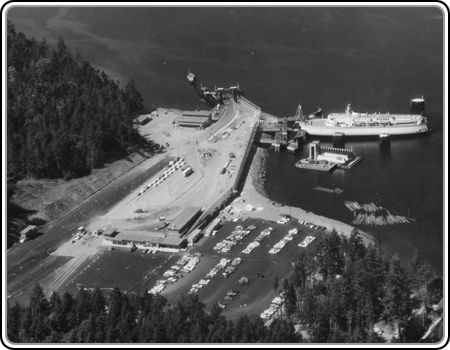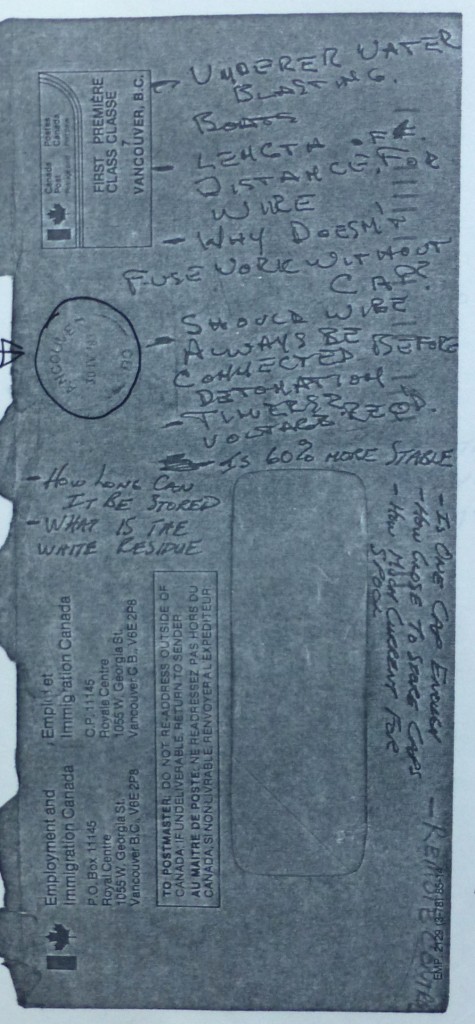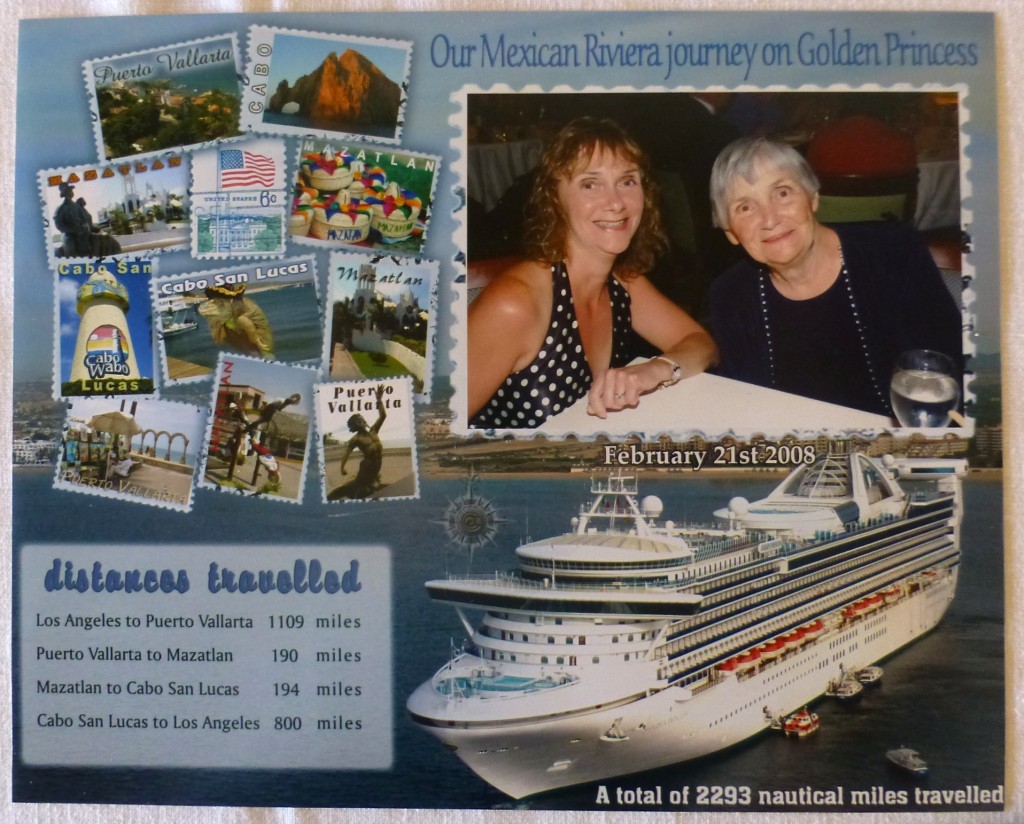Posts Tagged ‘Lynn McNeill’
Blue Tones Top the Charts
Get a Job – The Blue Tones
(The slideshow is in HD, so you may need to pause for 15 seconds while it uploads.)
A full series of still photos from this video can be accessed at:
McNeill Life Stories Facebook Page
Lead Singer and Saxophone Player: Art Charlton
Backup Singers: Alana Charlton, Linda and Bjorn Simonsen; Lynn and Harold McNeill;
Clair Langford and Tom
Practice Backup Singers: Benji and Kevin Charlton; Erika and Kia Simonsen,
Daphne and Danny Langford; Jay, Kari and Christine McNeill
Years of Struggle: The Back Story
After years of struggle, a British Columbia band from Victoria, the Blue Tones, knew it was do or die as they concentrated on putting the finishing touches to their song “Get a Job”.
The lyrics came straight from the heart as the four men knew that the women who had backed them for so long wanted more stability in their lives and if that meant the men had to give up their guitars, saxophones and rakish style for more menial work and a regular pay cheque, so be it.
Then came their big chance, back in early 1980’s, when a spot opened in Canada’s “So You Think You’ve Got Talent.” TV show. Another little known band “Lips Inc.” best know for their 1980 hit Funkytown failed to show for the taping of the show when another of those freakish July blizzards hit their hometown in Saskatoon, Saskatchewan. The Blue Tones were on standby and asked to step in. The rest is history.
Two months later Get a Job topped the charts in both Canada and the US. The attached video is a composite of the band’s work during the time they wrote and practised the song, then presented on the talent show. As you can see in the video, every one of their family members participated in getting it just right. Now you know the rest of the story.
We hope you enjoy this video of our first Golden Hit.
Harold
(142)
Happy Birthday Christine
Good Morning Honey and Happy 40th Birthday!
Well, another shared birthday which, for each of us, is a milestone – you reaching forty as I commence my seventy-fifth. The moment you arrived on my birthday forty years ago, a special bond was created and forever treasured.
It seems like yesterday when your mother gave birth and, while life has presented challenges along the way, meeting those challenges in a positive manner and accepting them as part of the process of growing older has made each of us stronger and our love that much deeper.
When sitting down to start a slideshow capturing those many years, it was difficult to choose a theme and music that expressed it all. I browsed through hundreds of photos and dozens of songs along the way to the final cut while suggestions from family members helped to clear the path.
Our journey began with one slideshow but quickly grew as we reminisced over 40 years of memories and the life we’ve shared – soon evolving into 4 segments which, along with the attached poem, express the depth of our love for you, your sister, brothers, and families.
We hope you enjoy each moment as much as we have enjoyed creating this tribute to you and the rest of the family.
Love Dad and Lynn
(Grandpa and Nana)
THE WOMAN YOU’VE BECOME
With those big eyes and sweet little smile
Your contentment so grand, the hours you’d while
Alone or with others, it mattered not
The love from within shone forth with each thought
Through the years it continued, this skill to enjoy
A moment, a dream, a specially made toy
Always sharing with others to help them to grow
More than imagined, and more than you know
We’ve sat on the sidelines and watched o’er the years
Through happiness, struggles, and of course, lots of tears
With each challenge you’ve managed to rise and excel
Each pitfall and obstacle all handled so well
It’s with pride and much love that we watch you soar
Now a wife, a mother, and so very much more
And on this day, one with Dad you share
We send these memories with loving care
And with each tune, — so familiar to some-
We rejoice in the Woman that you’ve become.
All our love on your 40th Birthday and Always
Lynn and Dad
Happy Birthday, Christine
January 13, 2016
Note: The slideshow was uploaded as HD so, in some instances, may be a little slow in loading.
1. The Adventure Begins: A Wonderful World, Louis Armstrong
2. The Adventure Continues: Precious Memories, J.J. Cale and
Dream a Little Dream of Me, Mama Cass
3. Girls Just Want to Have Fun: Cyndi Lauper
4. A New Family: I Have a Dream, ABBA
(202)
Graham and Harold’s Magical Christmas Adventure
Photo (Web Source, with a few Photoshop adjustments). In the mind’s eye Graham Hill makes his first
attempt at running the Skookumchuck Narrows. Gery Lemon preferred to stay on dry land. (December 2017)
Dear Graham and Gery,
While this post was written a month earlier, with the slideshow now complete it is time to go live. Rather than putting the slideshow at the end, it will be used as an introduction in an attempt to capture the spirit of the trip.
It was an amazing time, one I shall always cherish as it seems demands of life have conspired against finding that one-on-one time that only a trip like this can provide. Graham, you are an exceptional man, an easy conversationalist and your depth of knowledge on so many subjects are inspiring. Also, as you will no doubt agree, we have not only been gifted with the most amazing life partners, we also have a string of children, grandchildren and many friends who bring endless joy to our lives as we have moved along each successive stage. We could not have scripted our lives for a better result.
As for the following travel story, while I did not take any notes I hope that most of the family facts about your earlier life are correct and as for the make-believe stuff, that is simply a couple of old guys who remain daydream believers.
In preparing the final slideshow, the two of you will notice that I have plucked a dozen photographs from your respective Facebook pages to add flavour. Later, I will post all the photos on the open-access McNeill Life Stories Facebook Page so individual copies can be accessed at leisure.
In closing, many thanks to Herb Craig and Ann Skeltcher for their overnight hospitality on that lonely stretch of highway that leads to the hinterlands of the Sechelt Peninsula. There is nothing like good friends, a hot meal, glass of wine and a warm bed to take away the sting out of a hard day on the trail.
Your friend,
Harold
(January 16, 2016)
Individual photos of the Christmas Adventure now posted.
Another event involving Gery and Graham may be linked here: Gery Lemon Achieves New Milestone
Blog Post of Another Recent Event Harold and Graham attended: Wow! Another Slideshow
Introduction
Forever Young – Music by Joan Baez
1. A Narrow Escape
(1371)
The Magical Gardens of Adam F. Szczawinski
This post began as a short story about one man, our neighbour, Adam Szczawinski, the co-author of the above book and of several others he wrote during his illustrious career as a botanist. Adam’s story stretches from early in last century to the present day and is a story that seeks to provide reasons why the people of Canada, indeed of all countries, should care rather than hate, should help rather than reject.
Note: August 18, 2019: I hope many of you who start this post will read to the end, as Adam, the subject of this story, became a member of the Polish Squadron during the Battle of Britian. The men distinquished themselves throughout the war. A movie, Mission of Honour, followed the transition of Squadron 303 in Britain. Netflix Movie about the 303 Squadron
Introduction (Note: this is also the introduction posted on Facebook)
I began writing this, the third part of the Magical Gardens series, at a time when Canada had just entered what has become one of the most divisive, hate-filled elections I have witnessed in recent decades. While in previous elections the parties were unrelenting in their attacks on each other, in this election one party, in particular, choose to single out an ethnic group and a religion as the subject of their wrath. It did not take long before hate-filled invective became commonplace in newspapers, on T.V., radio and, in particular, in social media.
After having finished two light-hearted chapters about our immediate neighbour, a widower whose wife had passed away in the 1960’s and he in 2006, I became interested in finding out more about his early life. It did not take long to learn Adam was from a race and religion that became one of the most reviled in of the 20th Century, not only in Europe but also around the world.
It was a history that brought into stark relief a comparison with that which is happening around the world today with another race and religion. I hope you will find the time to work your way through to the end of this story as Adam’s story is a story “about all men and women who, because of war, famine, natural disaster, or bigotry, racism and hatred, are forced to flee their home and country for the safety of another.”
Regards, Harold
A Photo Album is now attached to this post: The Story of Adam
Link to Photos of a few of Adams Plants
Part 1: A Magical Summer
Link to Full Photo Series of Part 1
Part 2: Link to Crackling Fire on Cold Winters Day
The Story of the Polish Free Airforce in Britain
Mission of Honour – Netflix Movie about the 303 Squadron
1. A Friendly Face, a Gentle Smile
When Lynn, Jay, Sean and I moved to Leney Place in the early 1990’s, the one-acre property immediately across the street from our own was filled with all manner of native plants, shrubs and trees. The owner, a widower, had, as far as we knew, lived alone on the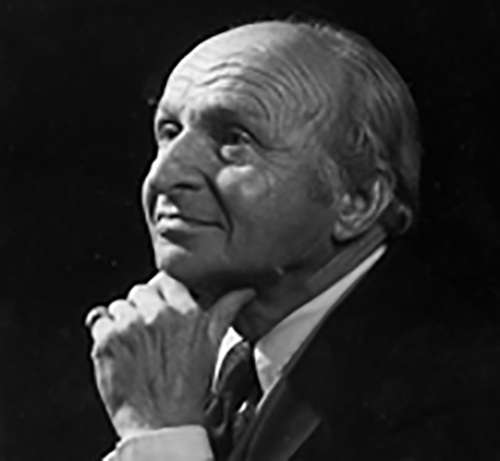 property for at least two decades before we arrived. He was a quiet, friendly man whose love of plants was evident and while we didn’t see him often, whenever we did he was always friendly and helpful.
property for at least two decades before we arrived. He was a quiet, friendly man whose love of plants was evident and while we didn’t see him often, whenever we did he was always friendly and helpful.
Web (undated Photo). Dr. Adam Szczawinski. Take a moment to reflect upon this man’s face and think about what is hidden in his past that should give us all pause to remember. I knew nothing about his early life when I wrote the first two chapters of this post.
Our family learned a little more about his past when, a few years after we arrived on Leney Place in Royal Oak, our older son Jay came home one day all excited, telling us the man next door gave him a book on Poisonous Plants and Mushrooms. The book was only published in 1991, so Adam, who autographed the book for Jay, was clearly a busy man when he wasn’t working in his garden. Those who know Jay will understand that books such as the one above are near and dear to his heart and Adam seemed like the gentle, caring sort who would gladly spend hours answering the dozens of questions Jay might ask.
The author, of course, was none other than Dr. Adam Szczawinski, a renowned botanist who, we only learned recently, had written dozens of books, some of which became the “to go” to source for all manner of information about plants native to Vancouver Island and Western North America.
At the time we became neighbours, Adam had long since retired and while we occasionally talked about plants and other neighbourhood interests, we never knew much about his past other than learning a bit more about his botanical expertise and that for years into his retirement he was much in demand as a lecturer and writer. As Adam grew older and weaker, the immediate neighbours kept a watchful eye out for him as he continued to live on his own.
One hot summers day when Sean, our youngest son was ten or twelve, he and I were playing in the yard when Sean heard feeble cries in the distance. After he drew my attention to the sounds we thought it might be a child or perhaps an animal in distress so we began to search for the source and finally zeroed in on the bush near Adams home.
It was there we discovered Adam collapsed in some shrubbery, barely conscious and crying for help. Lord knows how long he had been lying there fully exposed to the hot afternoon sun, but he was clearly in serious distress. After being taken to the hospital by ambulance, he was slowly rehydrated and a few days later returned home to continue his independent living. Then, one day in 2006, after seeing an ambulance at his residence, we learned Adam had passed away.
2. Books, Mushrooms, Plants, Shrubs and Trees: A Part of Adam’s Legacy
After Adam died, a new neighbour, Jim, moved in to look after the house and property. Jim, who was an avid gardener, continued tending to Adam’s collection with careful and capable hands. Jim was an equally friendly neighbour and over the years we often chit-chatted about our families, neighbourhood interests and, of course, plants. Thoughts about Adam faded until the spring of 2015 when the property on which Adam had lived for forty or more years sold to a developer who had the approval to sub-divide the acreage into three residential parcels.
Jim and his partner Julie moved to another house kitty-corner from our own and we all watched and wondered what might happen to all those beautiful plants that Adam, then Jim, had so carefully nurtured over the years. As Jim, Julie and I could not bear to see them end their lives in a pile of rubble or compost heap, over the spring and summer, with the blessing of the developer, we begin removing everything we could get our hands on. For me, a big catch was a ten-foot tall, bold red Camellia that used to sit by Adam’s front door.
 For the larger shrubs we needed a backhoe to excavate, so managed to gain the cooperation of a plant-loving backhoe operator who was scheduled to take down the house. He delicately scooped out the shrubs and gently placed them on the boulevard for us to take away at our leisure. The smaller ones could be moved with a dolly, but for that larger, including the Camellia with its 800-pound root ball, the aid of my long time police buddy Al Campbell and his front-end loader was needed.
For the larger shrubs we needed a backhoe to excavate, so managed to gain the cooperation of a plant-loving backhoe operator who was scheduled to take down the house. He delicately scooped out the shrubs and gently placed them on the boulevard for us to take away at our leisure. The smaller ones could be moved with a dolly, but for that larger, including the Camellia with its 800-pound root ball, the aid of my long time police buddy Al Campbell and his front-end loader was needed.
After digging a 5 X 5 X 5 hole in our front yard, Al picked up the shrub and dropped it with nary a hitch. The shrub was oriented in a shaded spot very similar to that from which it came and when it woke from its long winter’s nap, it simply shook its leaves as if to say “Wow! That was some dream.” (Photo left). By the time the contractor began levelling the lot, Jim, Julie and I had moved many dozens of Adams plants, shrubs, bulbs and small trees to new locations. All have not only survived, they have thrived.
And so this was the end of the original intent of this post, but after learning a little more about Adam’s life, I was inspired to learn more about this caring and gentle man whose life work as a botanist and activist in the field, made the world a better place. Clearly, there was much I didn’t know about a life that stretched back over nine decades than that which existed on a small patch of land in the Royal Oak area of West Sannich.
3. A Small World: The RBCM I am waiting for Bjorn Simonsen to proof this section when he returns from a current field trip.
I always knew a close family friend (who many of our extended family also know) was a mover and shaker in the development of the original Royal British Columbia Museum back in the late sixties and throughout the seventies. But, early in September when having coffee at the Oak Bay Marina with that friend, Bjorn Simonsen. the chat turned to Adam and the post I was writing. It turned out Bjorn knew Adam rather well as the two men were colleagues during the developmental years of the original British Columbia Provincial Museum. Bjorn, an archaeologist, spent over a decade in the 1970’s slogging away as he sought to gain for archaeology the recognition needed to better understand and preserve the long history and pre-history of British Columbia, particularly the native community with whom Bjorn has worked for the better part of fifty years (1).
During his tenure with government and after being appointed to the Office of the Provincial Archeologist (PAO), regulatory 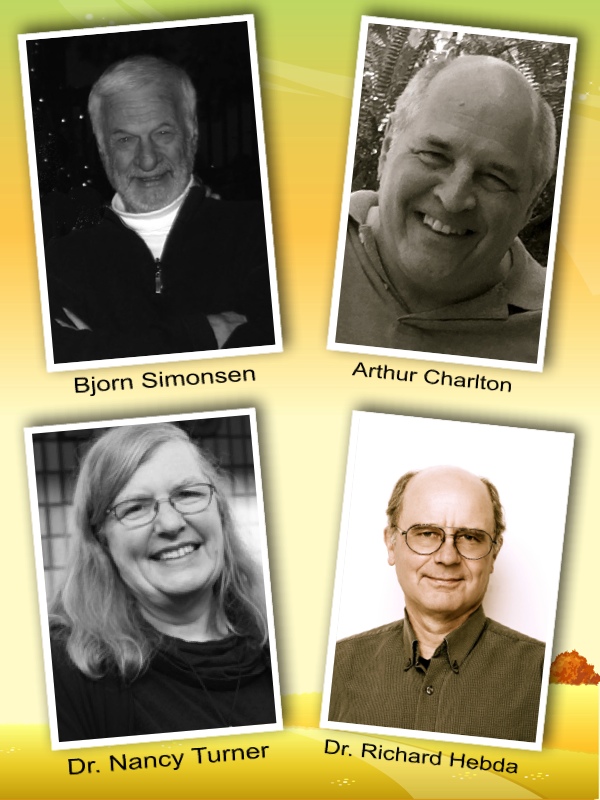 powers were expanded so that archaeology became much more than a discipline of academic interest only. After achieving the legislative backing, the PAO dedicated considerable time and energy to gain the funding needed to preserve the hundreds British Columbia historical sites that over the years were being systematically looted of thousands of treasured artifacts.
powers were expanded so that archaeology became much more than a discipline of academic interest only. After achieving the legislative backing, the PAO dedicated considerable time and energy to gain the funding needed to preserve the hundreds British Columbia historical sites that over the years were being systematically looted of thousands of treasured artifacts.
While Bjorn was working away in the Archaeological Branch, Adam was carrying on the same battle for Botanical interests, but Bjorn informed me that Adam, through his dogged determination and single-minded march towards the goals he had set, was a force to be reckoned with. Bjorn also named others who, in those early years, likewise set about building the groundwork for the amazing facility that now dominates the SE corner of Bellville and Government, the Royal British Columbia Museum.
Two of the others were, Art Charlton (2), and Dr. Richard Hebda (3), men who worked closely with Bjorn, Adam and others. In their younger years, Bjorn and Art completed post-graduate degrees in the Department of Archaeology at Simon Fraser University which, at that time, was at the leading at the leading edge of archaeological research in British Columbia.
Following his time working in the field, Art also spent time with the PAO, while Dr. Hebda went on to become Curator of Botany and Earth History at the Museum, the Branch in which Dr. Szczawinski was so deeply involved in developing. In addition to their wide range of collective interests, another key figure was Dr. Nancy Turner (4) a long time associate of Adam, who co-authored several books with Adam, including Common Poisonous Plants and Mushrooms of North America which Adam was working well into his retirement and was living next door in Royal Oak.
Following the connecting of these dots, I was able to locate articles about Adam which traced more of his life history. One article was posted on Canada.com and then another, written by Dr. Turner published in Davidsonia. The third was linked in a Web Site titled Descendants of Polish Squadrons (References in the footer). When the rest of the story began to emerge, it was not one I ever imagined when I first began to write this post. But, before delving into his earlier life, a bit more about Adam’s time at the Provincial Museum as outlined by Dr. Turner:
(Adam held) his position at the Provincial Museum until 1975, serving alongside Dr. Clifford Carl, Wilson Duff, Dr. Charlie Guiguet, Dr. Bristol Foster, and York Edwards, among others. During his time at the Museum, he served as Acting Director on many occasions. He also lectured widely throughout northwestern North America – sometimes speaking six or more times in a single week. He was in large measure responsible for the planning and implementation of the present Museum/Archives complex. Before this structure was built, the Museum was housed in the east wing of the Legislative Buildings.
Together with Dr. V. J. Krajina and others, he conceived and implemented the Ecological Reserves program in British Columbia, incurring considerable annoyance from politicians like Premier W.A.C. Bennett for his outspoken views on the importance of conserving representative ecosystems of the province. He also undertook extensive plant collecting in British Columbia and Yukon; most of his collections are housed at the Royal B.C. Museum herbarium (V) and at the University of British Columbia herbarium (UBC).
He helped to found Syesis, a research journal published by the Museum and was a founding member of the Canadian Botanical 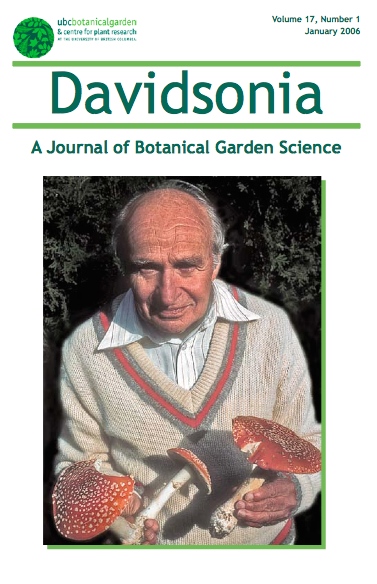 Association. He saw the Museum’s role in biological and ecological research as paramount and was a key developer and promoter of the Museum’s Handbook and Occasional Paper series. As well as recruiting authors for several of the handbooks (T.M.C. Taylor, Wilfred Schofield, Robert Scagel), he personally authored and co-authored several of Handbooks as well as co-authoring the Flora of the Saanich Peninsula (with A. S. Harrison).
Association. He saw the Museum’s role in biological and ecological research as paramount and was a key developer and promoter of the Museum’s Handbook and Occasional Paper series. As well as recruiting authors for several of the handbooks (T.M.C. Taylor, Wilfred Schofield, Robert Scagel), he personally authored and co-authored several of Handbooks as well as co-authoring the Flora of the Saanich Peninsula (with A. S. Harrison).
After his retirement in 1975, he continued to give many public lectures, especially on edible mushrooms and also co-authored five additional books: a set of four volumes on Edible Wild Plants of Canada (with N. J. Turner) and Common Poisonous Plants and Mushrooms of North America (with N. J. Turner).
Web Photo (edition not dated): During his years at the BC Museum, Dr. Szczawinski was often fondly referred to as the Mushroom Man, because of so many people requesting to see him while at his workplace at the BC Museum in order to get help identifying mushrooms. They either didn’t know his name or, perhaps didn’t how to pronounce it.
Another Davidsonia article provided background on Adam’s unrelenting push to see the B.C. Provincial Museum become a reality:
Szczawinski’s recommendation for a wilderness preserve caught the attention of the national media. Premier W.A.C. Bennett was not pleased; he sent a message through Dr. David B. Turner, Deputy Minister in the Department of Recreation and Conservation, and Clifford Carl for Szczawinski to stop opposing the government, or he would be dismissed.
Far from dampening Szczawinski’s enthusiasm, it challenged him to even more outspokenness. He told Carl, “Mr. Bennett is doing me a great favour by forcing me to get a better job.” He promptly contacted the media, and there were more headlines: “Provincial Botanist Muzzled by Premier.” Bennett, realizing that he could not intimidate Szczawinski, tried softer approaches, but, as Szczawinski recalled, “I said there’s nobody going to shut me up as far as conservation is concerned in the province. I was educated and my duty is to tell the government…”
Eventually, Mr. Bennett relented and invited Szczawinski to his office. There, he was very cordial and congratulated him on his dedication and on the wonderful job he was doing at the Museum. Not one to pass up an opportunity, Szczawinski seized the moment. “Museum? You call that a museum?” he said to Bennett. “Sir you know it’s about time British Columbia got out and had a proper museum!” Bennett, perhaps even further impressed by this audacity, assured him that he shouldn’t worry, that the government would do everything possible.
Later, in 1963, Szczawinski was invited to a government reception at the Empress Hotel. In the reception line, as Szczawinski approached the Premier to shake hands, Mr. Bennett said, “My friend, I have very good news for you. You are the first to know: We are going to build you a new museum!” Without hesitation, Szczawinski smiled and asked, “How big?” The Premier answered, “You tell us what you need and we’ll try to do it.
Thus, the dream of a new museum came to be a reality. It was opened officially by Premier W.A.C. Bennett on August 16, 1968. Its curatorial tower featured two floors dedicated to botany, including a large, modern herbarium to house the rapidly growing plant collection.” (Link to Source: Descendants of Polish Squadrons)
The Rest of the Story continues after these footnotes.
Footnotes
(i) Bjorn Simonsen: Bjorn has 40 years of experience as a professional archaeologist. He spent 10 years in the public sector, as the Provincial Archaeologist for BC. For the past (30) years, he has been an independent consultant involved in all aspects of heritage resource management and planning. This has included policy and program development; program evaluation; museum planning and exhibit research and design; heritage impact assessment; archaeological investigations; and community-based heritage program development on behalf of First Nations.
(2) Art Charlton: After spending several years with the Government working in the field of archaeology and at one time appointed as Provincial Archaeologist, Art, as with Bjorn, branched into consulting. His M.A. thesis involved excavation of the Balcarra Site “that focused on the later prehistory of the Strait of Georgia, a poorly understood period between A.D. 400 and 1200 and stands today as an important transitional study tracing the pre-history of Native Settlements in B.C. Sadly, Art passed away suddenly on September 1, 2015.
(3) Dr. Richard Hebda: Curator of botany and earth history at the Royal British Columbia Museum and the co-author of Saanich Ethnobotany. Richard Hebda has been with the Royal BC Museum since 1980, and Curator of Botany and Earth History since 1986. Since 1984 he has also held a faculty position at the University of Victoria’s School of Earth and Ocean Sciences. His PhD in botany is from the University of British Columbia.
(4) Dr. Nancy Turner: Distinguished Professor and Hakai Professor in Ethnoecology, Nancy Turner is an ethnobotanist whose research integrates the fields of botany and ecology with anthropology, geography and linguistics, among others. She is interested in the traditional knowledge systems and traditional land and resource management systems of Indigenous Peoples, particularly in western Canada.
(5) There is an EndNote on this post which links a few more connections in this small world in which we live.
4. Dr. Adam Szczawinski: The Rest of the Story
Born 1913 baby Adam was welcomed into a middle-class home in Lwow, Poland, where his father managed an estate and was a forester by training. With the freedom to choose and abundant educational opportunities, Adam seized every chance throughout his early life to take on new challenges including earning a PhD in Botany at the University of Lwow (1). In her biography, Dr. Turner captured the essence of the young Adam:
His maternal grandmother, Mrs. Pluchtnyak, who rode horses until she was in her 80s, especially influenced him as a child. When he turned 12, Adam was given his own horse, Cashtanka (“horse chestnut”) as a birthday present from his father. He used to ride far into the forest by himself, through the beech woods, on Cashtanka. One day, he encountered an old woman who was considered the village witch. She was collecting fly agaric mushrooms, and she made Adam climb down from his horse so she could tell his fortune.
She wrapped the skin of the mushroom cap on her forehead and her tongue, and then she went into a trance. She held his hand and said, “Oh! I see big fire, huge fire, and you are running away. And you go through the water, plenty water! And the other side, and you are safe there. And then the big war started. You were on the other side, and then you were safe.” Adam recounted this story to me in 2002. He laughed at the old woman then, but remarked in hindsight, “More or less, in a few years, I found out that she was right!”. Adam attended the University of Lwow (1) from 1932 to 1937, where he studied botany and medicine. In 1936, he became a lecturer in biology at the Commercial College in Lwow, and in 1937, an instructor at the University of Lwow.”
Given Adam’s family history, it is easy to see why he choose a life path that propelled him towards the study of botany. But, just as he was getting started, his bright and peaceful future came to a crashing halt in 1939. In that year the Second World War began, a hate-filled war that led Adam to family tragedy, escapes filled with danger, service in the Polish Underground and then Air Force, a promotion and service with the British RAF and, finally, to redemption in the form of a new love and new country, a second PhD, again in Botany, but this time at UBC, and finally a fulfilling career studying the plant species on Vancouver Island and Western North America. Adam’s story is the story of an extraordinary man who overcame the adversity brought on by bigotry, racism, and hatred. Adam, as you might have guessed by the name,, was a Polish Jew.
In the dark days of 1939, Adam managed to escape Russians in his section of occupied Poland, but his freedom was short lived when in 1940 he was then captured by the Gestapo in Hungary and thrown into a concentration camp near Budapest. The life expectancy of Polish Jews at the time was very short indeed and although Adam faced immense odds against his survival, a relentless determination that obviously stuck with him throughout his life, helped him to escape and reach France. He immediately joined the free Polish Air Force, but a short time later when Germans overran France, he and his squadron were forced to make a harrowing escape to Britain (2) where they would spend the remainder of the war.
Dr. Turner continues:
Arriving in Great Britain by perilous convoy from France (2), he served as Director of Education, at the Polish Air Force Headquarters in London from 1944 to 1946. He was promoted to the rank of Flight Lieutenant, in the Royal Air Force in 1946. He fell in love with and married Mary, his beautiful Scottish wife, (Mary M. McAlpine) and together they emigrated to Canada in 1948.
After an unsuccessful effort at farming on Lulu Island – potatoes, strawberries, and cut flowers – and a somewhat disastrous time as a boiler fireman for Aylmer’s fruit and vegetable cannery, he decided to go back to university. With the support of many, especially Czech forest ecologist Dr. Vladimir Krajina, he received his Ph.D. through the Department of Botany, at the University of British Columbia, in 1953. He was UBC’s first PhD recipient in botany.
His doctoral research was undertaken in the Nanaimo River Valley (Nanaimo Lakes area), where he salvaged canopy lichens from the Old Growth trees that were being logged. He stayed for long periods of time in isolation while he did his fieldwork, and recalled once or twice seeing a large cougar crouched in a tree over his head when he went down to get water from the creek. His thesis was entitled Corticolous and lignicolous plant communities in the forest associations of the Douglas-fir forest on Vancouver Island. As a graduate student, he and Mary struggled to make ends meet, and they were often helped out by Professor Krajina and other kindly individuals.
After completing his PhD, he remained as a lecturer in the Department of Botany at UBC until 1955, when he took the position as Curator of Botany and Head of the Botany Division at the British Columbia Provincial Museum [now Royal British Columbia Museum] in Victoria. Mary gave birth to their only child, their son Alan, in 1956. Tragically, in 1968, when Alan was only 12 years old, Mary died suddenly from a heart attack; Adam never remarried.
This brings us to the present day where this post began in West Saanich. Clearly many of the specifics of Adam’s earlier life were not documented in the posted articles, but one only needs to look at what was happening around him during the 30’s and 40’s to see that because the Jewish race and religion were seen to be a blight on mankind, Adam and hundreds of thousands of others were forced to flee their home and country or be killed. We have all watched that happen in other parts of the world at one time or another, but never on the scale that happened in the 1930’s and 40’s in Europe. It was the greatest mass movement of refugees the likes of which the world had never before experienced.
Today as we watch the flood of refugees seeking to escape the war zones and crisis in the Middle East, we are again forced to confront the bigotry, racism and hatred that is standing in the way of our helping innocent people simply because they are of a different race, have different customs and from a different theist belief stream. How is it possible we can so easily forget what happened a mere 70 – 80 years ago knowing full well what happened then involved the grandparents and great-grandparents of many who now call Canada home. Adam was just one of those people who escaped and although we know that which was done to Adam and his Polish family was wrong, we continue along a similar path today knowing that bigotry, racism, and hatred bring nothing but more pain and suffering to all concerned. More will be said on this subject in the next section “Least We Forget.”
Footnotes
(1) Massacre of Lviv University Professors: In 1941, 25 Polish Academics and their families from the University of Lwow were executed by Nazi Occupation Forces with the hope that that the killing of prominent members of the community would weaken the Polish Resistance Movement. As Adam had completed his post-graduate studies at Lwow University between 1932-1937, and in 1937 became a teacher at the University, he would no doubt have been a close associate and friend to many who were killed. A reference is made in another Davidsonia article that Adam was a member of the Polish Resistance Movement before he fled Poland. (For the full background on the subject of these murders as well as a list lot all those killed — Link Here)
(2) In another Davidsonia account of Adam’s time in France, it is suggested he was captured by the Germans but later escaped to Britain. Which story is correct, I don’t know, but it makes little difference as Adam dodged so many bullets after the invasion of Poland, his survival might well be considered a miracle.
5. Least We Forget: Concluding Comments
In Canada, November 11th is set aside to remember Canadian soldiers who died during the First and Second World Wars, men and women who died in order to help make Canada and the world a better place. We justifiably make a big deal of remembering that terrible time in world history, not only because so many innocent people died, but because we wish to remember why it is we need to do better in the present. Let’s travel back to Adam’s world in 1939.
Following the German and Russian occupation of Poland and in the early years of the war, the city of Lwow became home to the largest Jewish Ghetto in occupied Europe, a home that, in the final days of 1941, held upwards of 220,000 Jewish people in 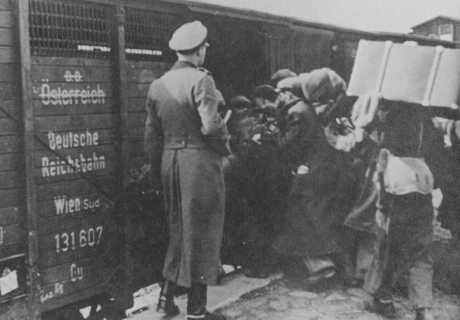 extreme deprivation. By 1943 all who had not died of disease or starvation, or were summarily executed on site, were hauled away in cattle cars to certain death in the gothic horror that was the Bełżec Extermination Camp. Out of an original Jewish population of 110,000 in and around Lwow, it is reported that only 200 to 800 survived. I have no firsthand information as to what became of Adams family and friends (other than the University Professors and their families), but in the absence of definitive information to the contrary, it seems likely some or all of them met a tragic end.
extreme deprivation. By 1943 all who had not died of disease or starvation, or were summarily executed on site, were hauled away in cattle cars to certain death in the gothic horror that was the Bełżec Extermination Camp. Out of an original Jewish population of 110,000 in and around Lwow, it is reported that only 200 to 800 survived. I have no firsthand information as to what became of Adams family and friends (other than the University Professors and their families), but in the absence of definitive information to the contrary, it seems likely some or all of them met a tragic end.
The attempt to eradicate an entire race and religion during the Second World War is certainly not unique over the past 100 years, but the depths to which Germany, an overwhelmingly Christian country fell during the 30’s and 40’s would be hard to match at any time in world history, although Russia probably came close. While the Holocaust lead to the deaths of an estimated 6,000,ooo Jews, a further 5,500,000 “Romanis, ethnic Poles and other Slavs, Soviet POWs, communists, homosexuals, Jehovah’s Witnesses and the mentally and physically disabled” all felt the wrath of that hatred (i). But, when talking about killing large numbers, whether it is two hundred or 20 million, the cause will usually be traced to bigotry, racism and hatred directed towards specific groups.
Looking at the above photograph of Jews in Poland being loaded into cattle cars, you can certainly see similarities to that which is happening in the world today when many refugees are being treated worse than cattle in a feed lot. At least cattle in a feed lot are usually given food and water. Why is this happening? Because bigotry, racism and hatred is being directed towards the 1.57 billion people who consider themselves Muslim even though we know the vast percentage of those people are no more prone to violence than are Christians, Jews or any other group, yet they are all lumped in the same basket. It is a tragic indictment of all who claim to be caring Christians, Jews and yes, Muslims who hate other Muslims, that many will stand back and just let this happen. Now, think for a moment how it can be different.
Germany, a Christian nation, is taking the lead in trying to deal with the rapidly escalating refugee crisis and one cannot help but admire the German Government and people for their selfless effort in trying to bring some sanity to a humanitarian disaster of immense proportions. The same cannot be said for many other countries in Europe, Canada and elsewhere who have largely turned a blind eye to the crisis. You can be sure bigotry and racism play a big role in the decision to just ‘stand-by’ as “we” have been told “those people” are dangerous and in Canada, that message has been preached for the past decade and is an election issue as I draft this post.
Our response, send six CF-18 fighter jet fighters and a hand handful of the military to confront a dangerous, deprived group called ISIS who have killed perhaps 1,500 people over the past few years in a lawless land where tens of thousands have been killed. As well, the government has crafted a handful of anti-terror bills to combat the ‘growing problem’ at home because so-called terrorists have killed two or three people in the past twenty years. All those words and actions is just window dressing designed to make it appear Canada is a leader in the fight against terrorism. Now, think back to Canada in an earlier time.
In Adam’s dash to freedom from his home in Poland, he faced almost certain death on many occasions and, later, had to face down the bigotry and racism the Jewish people endured in the last century. I don’t have direct information, but it seems likely Adam and his Scottish bride were among the thousands of refugees taken into Canada in 1948, a time when the population of Canada was a mere 11 million. Today Canada struggles to take in a few hundred when our population is 33,000,000 and our resource base is exponentially higher than it was in 1948.
his Scottish bride were among the thousands of refugees taken into Canada in 1948, a time when the population of Canada was a mere 11 million. Today Canada struggles to take in a few hundred when our population is 33,000,000 and our resource base is exponentially higher than it was in 1948.
Web Source (PDF screen shot): Canada Accepts Jews (double clip to open)
While the acceptance of something in the order of 180,000 refugees, including some 7,000 Jews, into Canada, was significant, resistance to that influx remained high. Never-the-less our country was able to dig deep to overcome the bigotry and hatred directed towards the Jewish people and others considered less than deserving of a place in Canada.
Strangely, all those people accepted into Canada after the war will now be the grandparents and great-grandparents of those living today and who make up the mosaic that is Canada. Yet many of those who are now second and third generation will be among those railing against accepting immigrants and refugees. This includes members of my own extended family. Ah, but the new threats to the world are no longer the Chinese, the Japanese, the Germans or the Jews, as those groups have all been replaced by Muslims. Is it possible for Canada overcome bigotry, racism and hatred in order to again achieve a level of compassion needed to help? Who knows.
Only time will tell if extremists, be they Christians, Muslims or Jews, and to be clear it is the extremist segment only, will one day be pushed aside by the peaceful mainstream or whether, through bigotry and racism, those extremists will be given a podium on which to spread their hate. In the meantime, as we dither, millions of innocent people have been caught in the pincers of war as happened in Adam’s Poland in the last century, is happening in Syria and other Middle East countries today and as has happened in other countries around the world throughout the intervening years (2).
I won’t pretend to have a lasting solution to the many conflicts that currently exist, but I do know that Canada, along with the hundreds of ‘rich’ and relatively peaceful countries sprinkled around the globe have an obligation to use their good will and a good part of their resource base to help those who struggle to scratch out an existence in the most horrendous conditions. To stand by and watch while hoping for the best is not an option.
Part of Adam’s story is presented here as a reminder of the strife endured by many who fled to Canada over the past 200 years. We are a nation built by immigrants and refugees for immigrants and refugees, so we have an obligation to help.. Adams story is being developed here an example of how the world becomes a better place when bigotry and racism is set aside and the down trodden welcomed.
Footnotes.
(1) In the nearly fifteen decades since Confederation, Canada has experienced many threats to national security, yet, during that fifteen decades, the past seven have been the most peaceful in our history. Clearly the greatest threat we and the world faced in the past 150 years, was the advance of the German Military in Europe and the Japanese Imperial Forces in the Pacific during World War II. Those two nations developed the most fearsome fighting forces of all time and although they were finally defeated by a massive allied effort, victory was by no means a given. Had it not been for a megalomaniacal leaders and their immediate followers thinking their forces were invincible, and thinking that people in the countries they overran could be controlled by brutal repression, they might well have succeeded. All other threats to world peace, both before and after that war, have paled by comparison.
(2) As dangerous and brutal as organizations like the Taliban, ISIS, other splinter groups and various dictators may be, the destruction they bring pales in comparison to the wartime forces of Germany and Japan, followed by Russia during in Stalinist years. Terrorists and dictators can only survive and thrive in countries were civil society has disintegrated and the rule of law extinguished. While they can do considerable local damage, their ability to gain the widespread support needed to achieve their delusional goals, is limited. Many nations buy into their tactics by spreading fear of terrorists for political and ideological ends as is happening in many countries around the world in the current day. Unfortunately, this has the effect of greatly damaging innocent people such as the refugees from Syria and surrounding countries who are caught in the cross-fire.
References
Descendants of Polish Squadrons: Several articles from Davidsonia provides the most comprehensive background on Dr. Adam Szczawinski that I was able to find on the Web. In reading through the various versions of his past there are a number of conflicting bits of information, but these conflicts are insignificant in the overall documentation of his life. On a lighter note, during his time at the RBCM, Adam was known as the “mushroom man” whenever people called to speak to him. Others, including Bjorn, also noted Adam was a colourful character who was fond of driving a powerful hotrod that was maintained in his garage until the day he died.
Davidsonia Article: Adam F. Szczawinski, A Botanical Pioneer in British Columbia. Adapted from article by Dr. Nancy J. Turner, CM, OBC, PhD, FRSC, FLS, Dr. Turner is a distinguished Professor of Environmental Studies at the University of Victoria in British Columbia (Link):
Canada.com Botanist helped B.C. museum bloom
Times Colonist, Obituary June 9 to June 10, 2006
Publications: Adam F. Szczawinski
Bandoni, R.J. and A. F. Szczawinski. 1976.
Mushrooms of British Columbia. British Columbia Provincial Museum Handbook Number 24, Victoria.
Szczawinski, A. F. 1959.
The Orchids of British Columbia. British Columbia Provincial Museum Handbook Number 16, Victoria.
Szczawinski, A. F. 1962.
The Heather Family (Ericaceae) of British Columbia. British Columbia Provincial Museum Handbook Number 19, Victoria.
Szczawinski, A. F. & G.A. Hardy. 1975.
Guide to Common Edible Plants of British Columbia. British Columbia Provincial Museum Handbook Number 20, Victoria.
Szczawinski, A. F. & G.A. Hardy. 1975.
Guide to Common Edible Plants of British Columbia. British Columbia Provincial Museum Handbook Number 20, Victoria.
Szczawinski, A. F. & A. S. Harrison. 1973.
Flora of the Saanich Peninsula. Occasional Papers of the British Columbia Provincial Museum No. 16
Szczawinski, Adam F. & Nancy J. Turner. 1978.
Edible Garden Weeds of Canada. Edible Wild Plants of Canada No. 1. National Museum of Natural Sciences, National Museums of Canada, Ottawa.
Szczawinski, Adam F. & Nancy J. Turner. 1980.
Wild Green Vegetables of Canada. Edible Wild Plants of Canada No. 4. National Museum of Natural Sciences, National Museums of Canada, Ottawa.
Turner, Nancy J. & Adam F. Szczawinski. 1979.
Edible Wild Fruits and Nuts of Canada. Edible Wild Plants of Canada No. 3. National Museum of Natural Sciences, National Museums of Canada, Ottawa.
Turner, Nancy J. & Adam F. Szczawinski. 1978.
Wild Coffee and Tea Substitutes of Canada. Edible Wild Plants of Canada No. 2. National Museum of Natural Sciences, National Museums of Canada, Ottawa.
Turner, Nancy J. & Adam F. Szczawinski. 1991.
Common Poisonous Plants and Mushrooms of North America. Timber Press, Portland, Oregon. (Paperback edition published in February 1995) [American Library Association awards: Outstanding Reference Source 1991; and Outstanding Academic Books and Nonprint Materials 1991, from Choice magazine, the journal of academic libraries.]
End Note: More on the Small World in which we live.
Art Charlton and his wife Alan, along with Bjorn, Linda, Lynn and I and our severn children (Ben, Kevin – Charlton; Erika, Kia (Simonsen); and, Jay, Kari and Christine – McNeill) often partied together during those early years. One notable event was getting together to enter Lip Sync Contests at local dances. Our all time favourite was our Blue Tones rendition of “Get a Job” for which I shall soon be posting the photos for the Charlton family as, sadly, Art passed away suddenly on September 1, this year. Art, Alana and their family lived only a stones throw from the Oak Bay Police office were Lynn and I worked.
A continuation of previously unknown connections to our small world occurred September 28, 2015, while Lynn and I were visiting the kids in Kamloops. When the subject of this post came up in a discussion with our son-in-law Chris LeClair (a geologist) and his father Ron LeClair, Ron mentioned he was a colleague of both Bjorn Simonsen and Art Charlton as all three attended post-graduate studies at SFU. Ron had worked the Balcarra dig with Art Charlton and it was Art who encouraged Ron to apply to the SFU post-grad program. There is no direct connection to Adam, but the connection shows how small the world can be when searching for connections between people with diverse backgrounds. People of the earth are one family.
End Note 2 October 4, 2015. The following information on another part of the Szczawinski family was located through a photo search on the web. It is unknown if this family was related to Adam’s, but it certainly seems possible as this story relates to very similar circumstances that Adam’s family faced in Easter Poland: (Link to Source: The Szczawinski Family
Before the Second World War, 60 percent of the population of Ostroh, a town by the Russian border on the Horyn River, was comprised of Jews. When the Nazi occupation began, a ghetto for the Jews was set up. In 1942, the liquidation of the ghetto begun. The whole of Ostroh were able to hear the sound of executions carried out on a meadow by the forest. At that time, the Szczawiński family was visited by some acquaintances: Samuel Klepacz, a carpenter who had laid the floor and built a porch at Szczawińskis’ house, together with his fiancée Sima Rozliwkier. They stayed until the liberation in 1944.
The only person to know about the Jews’ presence was Eugenia Szczawińska and her three children: Antonina, Edward, and Adam Tadeusz. The remaining four siblings had no idea of what was hidden in the unfinished part of the house that served as a barn. A Russian soldier, temporarily staying at the house, didn’t know either, and even Mr. Antoni Szczawiński didn’t know.
“Daddy was a manager at a workshop where Germans would come and order stuff. So, if they had a drink together, he might have accidentally said something and we would have had a search of the house.”
The shelter under the barn floor was dug by Samuel and Antonina’s brothers, while she was on the watch. Later, she brought food, water, towels and soap, washed the bed linen and clothes, and removed the waste. Samuel and Sima could only leave the hideout for a short amount of time every couple of nights. They spent nearly two years in hiding and their health suffered a lot. They both had rheumatism, and Sima nearly lost her sight.
For two months they were accompanied in the shelter by Lina Nusinow. He was a twelve-year-old boy who had previously been hiding in a ravine with his parents. Exhausted physically and mentally, he died of pneumonia and was buried in the Szczawińskis’ orchard.
After the war Sima and Samuel married and left for Israel shortly after. Antonina, aside from taking care of the house and children, also repaired stockings, and worked as a culture and education instructor, a boarding house tutor, and a mangle operator. She lives with her husband in Warsaw.
(787)
Conspiracy to Rob the BC Ferry Terminal at Swartz Bay
Swartz Bay Ferry Terminal 1983 (Web Source)
On the May Day long weekend in 1983, a dozen police officers waited patiently with weapons at ready. The gang that commanded their attention had amassed a small arsenal of handguns, shotguns, rifles and even considered mounting a machine gun in the back of a stolen van. The gang also collected a box of dynamite and purchased blasting caps, radio transmitters, scanners, balaclavas and sundry other equipment to pull off a major heist. The gang leader was a convicted bank robber from the Vancouver Lower Mainland (White Rock area) who made no bones about killing if that should become necessary.
The gang had the planning down to the minute, the goal, a small fortune in cash that flowed through the Swartz Bay Ferry Terminal every long weekend. The only thing that stood between the gang and that goal was a small group of police officers and civilians who had quietly, deliberately, and secretly inserted themselves into the gang planning process.
Link here to Part I of this Series: Oversight of Police and Security
Link here to Part II of the series: Conspiracy to Bomb the BC Legislature
Part III Conspiracy to Rob the BC Ferry Terminal at Swartz Bay
An earlier post about BC Ferries posted on McNeill Life Stories: Thank you BC Ferries
1. Introduction
In Part II, a Conspiracy to Bomb the British Columbia Legislature, the crime was meticulously orchestrated over a five month period by 250 RCMP General and Security Service police officers. While many were only peripherally involved, two undercover officers maintained close personal ties with the two suspects.
During this period, the suspects were coached, cajoled, encouraged, threatened, and supported along a path that led them to the BC Provincial Legislature grounds in the summer of 2013. In culminating the crime, pressure cooker bombs where strategically placed on the BC Legislature grounds the night before the Canada Day celebrations of July 2013 were to be held.
As the crime was planned and monitored by the police, the bombs were inert, so there was no danger to the public. However, with considerable fanfare and live television following, the suspects were arrested in an ERT take down the next day at a Fraser Valley motel. Read the full story as linked above.
In this post, an Armed Robbery was carried out as part of a Conspiracy to Rob of the BC Ferries terminal at Swartz Bay. The commission and planning of these robberies were carried out by a half dozen suspects, while an equal number of police officers (Note 3) took turns following them, listening to their conversations, as well as collecting evidence as it became available. During the five-week investigation, the suspects had no idea police were listening in as well as watching their every move. It was a classic conspiracy investigation.
The investigation took place in early 1983 while I was working as a Detective with the Co-ordinated Law Enforcement Unit (CLEU), a joint forces operation that included five RCMP and six Municipal/City members. There was also a civilian support team of ten, including one pilot who worked with the surveillance teams. The unit was under the overall control of a Joint Management Team (JMT) made up of senior police officers and government officials from the Greater Victoria area.
The team was assigned complex multijurisdictional cases that often involved drug trafficking but periodically spun off to other criminal cases as in the present case. CLEU members also provided specialized support to local police agencies as needed. One example was an Oak Bay PD, in a case involving the theft of art. (Surveillance in an Art Theft). The cases regularly involved mobile and stationary surveillance as well as telephone and other listening device intercepts. As with most CLEU operations, there were never enough bodies to go around, so some intercepted call lines were only monitored on an “as needed” basis if things became hot on one or two other files.
So it was on this particular morning when, having a few minutes to spare, I grabbed a reel of EHUR recordings from a less active line. This was done periodically to catch up on the calls since the last logged entry. As usual with residential telephone lines, many calls were idle chitchat between family, friends and business associates. It only took a few days of listening to become familiar with the habits of the regular users, including their humorous attempts at cloaking some conversations in code. Following is a simplistic example.
“Hey Donaldson, you wanna buy some…”
“Carl you fuck, don’t use my last name and talk in code, OK?”
“Okay, okay, Jimmm…, don’t get pissed?. Hey, you wanna buy some “pizza”? Got some good shit.”
“Carl, we gotta be careful, cops might be listening.”
“Nah, cops are too stupid. Anyway, how many pizzas do you want, I’m making a pickup today?”
“OK, the usual, meet you later at the pond.”
Every group developed their own codes and almost all worried about their phones being bugged, but that never stopped any from talking as if their line was secure and as if their secret codes would confuse the police. A few might revert to a payphone, but when that happened, it was usually the same phone so the wiretap was simply extended to that line and intercepted only when they were on the line. That usually meant we had to cover off the call if possible. In the above example, Jim might have said at the beginning: “Give me thirty minutes, I’ll use the other phone.”
2. An investigative break in the Armed Robbery of the Brentwood Bay Liquor Store
On this particular day while listening to the early morning calls of a few days earlier, nothing much popped up until around noon (call time) when an unknown male (UM) made a series of calls to various stores looking to purchase a starter pistol. After a half dozen attempts including calls to Jeune Brothers, Ray’s Sporting Goods, Island Collateral, International Knives, etc., the man finally found pistols at Robinson’s Sporting Goods. They stocked several kinds, some of which could be purchased for as little as $20.00, so the UM told the clerk he would drop by later.
A similar pattern followed the next day calls, but this time they were made by an unknown female (UF) trying to purchase balaclavas. After contacting half dozen sporting good stores and no balaclavas to be found, the woman decided to settle for normal toques.
On the third day the line yielded pay-dirt when the UF of the previous day called from a pay booth to the target residence and spoke to the UM of the first day:
UM: “Hello” (this was followed by two faint shots from what appeared to be a small calibre handgun or starter pistol).
UF: “Police, oh God, you’ve gotta’ help us, somebody with a gun. I’m at the Waddling Dog Inn. Please send somebody.” (this was followed by normal conversation)
UF: “I just worked – we haven’t worked out what we’re uh how things are going. How’s it goin’? Can you hear that?”
UM: “Yeah, I didn’t un there’s not un yeah.”
UF: “Can you hear anything?”
UM: “Not much, no.”
UF: “OK, let me try again, just a minute.” (Again, two faint shots)
UF “We haven’t worked out our dialogue see we’re just practicing.”
UM: “Oh, that was pretty good.
The conversation extended a further ten minutes as the female was clearly self-conscious and uncertain as to whether her plea for help sounded convincing. The male attempted to reassure her but was more worried about whether the shots sounded realistic. The conversation suggested the two had a personal relationship. The call was traced to a phone booth in the parking lot at the Waddling Dog Inn at the intersection of Highway 17 (Pat Bay Highway) and Mount Newton Cross Road.
This call was the first break in an armed robbery that occurred a few days earlier at the Brentwood Bay Liquor Store in which two men wearing balaclavas and one threatening with a handgun accosted the store manager and stole the bank deposit bag containing nearly $7000. As the robbery was going down, the above female phoned the Central Saanich Police (CSP)office and made a report similar to her earlier practice call of a shooting at the Waddling Dog Inn.
Following is a partial transcript from the police tape of the robbery and shooting call:
Male Caller (MC): “This is the Liquor Store at Brentwood. I got held up by a man with a gun in a red van Licence number 12-34-AB.”
Dispatcher (Disp): “O.K.”
MC: “Towards you on Wallace Drive”
Disp: “O.K.”
MC: “The right-hand door was torn off.”
Disp: “Right-hand door torn off it, O.K. just stay on the line, was this an armed robbery?”
MC: “Yes, it was”
Disp: “O.K., what type of weapon.”
MC: “It was a revolver.”
Disp: “A revolver, and how many men.”
MC: “Two.”
Disp: (APB on Radio) “Liquor store in Brentwood Bay was just robbed, armed robbery, BCL 12-34-AB, a red van and its heading down Wallace Drive towards us. (to MC)”Just stay on the line, sir:”
MC: “O.K.”
Disp: (on the radio) “120 Central Saanich, contains two males, 120 Central Saanich.” (on phone) “Just stay on the line, sir.”
120: “120”
Disp: “We’ve just had a robbery at the Liquor Store (phone rings) vehicle involved is a red van #12-34-Alpha Bravo (rings) the van is proceeding north on Wallace Drive towards our office (rings), two males with a handgun (rings) revolver involved.
Disp (aside): “Stay on the line sir”
Disp: (answers another phone). “Central Saanich Police” (the sound of two faint shots can be heard)
Female Caller (FC): “Police, my God can you send somebody down to the Waddling Dog Hotel, there’s a man with a gun and somebody has been shot already – OH MY GOD.”
Disp: “O.K. Mam you said there’s .. stand by Mam hello (phone rings) “Just stay on the line sir.”
MC: “Yes, I’m right here.”
Disp: “Mam you said there’s, stand by, Mam hello.” (Caller apparently hung up) (rings) “Just stay on the line sir”
MC: “Yes, I’m right here.”
Disp: “122, 120 Central Saanich I’ve just had another report that there is a man with a gun at the Waddling Dog and someone has been shot, apparently the caller, a female has hung up, I have no further information on that nor a description.
120: “Central Saanich 120, I’m 100 yards off the Waddling Dog, I have Constable Henn, off duty, with me.
Disp: “10-4 description of the van was a red van BCL 12-34-Alpha Bravo,,, two males with a handgun, stand by O.K
120: “10-4, get some backup from Sidney and Saanich.”
Disp: “Standby sir, I ‘m just going to keep you on hold OK, but stay on the line.”
122 “122 Central Saanich”
Disp: “122:
122: “Do you still have the liquor store on hold?”
Disp: “10-4”
122: “Don’t let anyone in till I get there and lock the doors.”
Disp: “10-4 (then to male caller): O.K. police will be their shortly, secure all the doors. Hello”
Communication by radio and phone continued for several minutes as other units from Sidney RCMP and Saanich PD set up to assist. When CSP 122 arrived at the liquor store, the store confirmed the arrival with the dispatcher, then hung up. CSP 120 at the Waddling could find no evidence of anyone having been shot.
(Note: the manner in which the CSP Dispatcher, on her own in the CSP office, handled this situation, was a classic example of keeping one’s cool under pressure.)
Back at the Liquor store witness reports indicated the robbers were observed sitting in the red van in the parking lot. Things went sideways from the beginning as just when the robbery was about to go down, a woman drove into the parking lot and stopped to let the liquor store manager walk by in front of her car. Right after the manager passed, a passenger in a red Van threw open the sliding door, jumped out with his face covered with a balaclava, shoved a handgun in the managers face and ordered the manager to hand over the deposit bag. Instead, the startled manager dropped the bag. The robber scooped it up, jumped back in the van, but just as he was part way in and pulling the door closed, his partner hit the gas. This forced the sliding door to slam back open and nearly pulled the masked gunman from the vehicle.
As the witness vehicle partially blocked the exit route, the get-a-way driver cut short to the right and in doing so caught a parked car that ripped the sliding door off the van. It was left lying in the parking lot and it was pure luck the gunman was not squished between the two vehicles. Had that happened the case would have long since been solved and that would have been the end of this story.
As it was, an hour later, a CSP unit found the get-a-way van abandoned in a commercial parking lot off Keating Cross Road. It was soon determined the van was stolen earlier that morning from the long-term parking area at the Swartz Bay Ferry Terminal. Also stolen were two sets of BC licence plates from other vehicles in the same lot.
3. The Follow-up Begins
In a meeting with CSP investigators, it was clear there was no physical evidence, other than the phone calls made between the mystery male and female, connecting specific person(s) to the crime. It seemed likely those at our target residence were complicit in the robbery, but a lot more work was needed to pin things down to specific individuals.
While we carried out periodic regular surveillance of the target residence, another drug trafficking case was demanding considerable attention, so the best we could do was rotate between the two cases as priorities allowed. CSP provided additional assistance whenever needed.
Given both monitored residences were in rural, somewhat isolated areas, onsite surveillance was nearly impossible. The best we could do at the Saanich residence was station a car at each end of the through road, then conduct periodic spot checks as we drove-by. In the East Sooke case, the house was on an isolated dead-end road so one car could maintain regular checks when required. In both cases the houses had a single driveway and, as the parking areas were visible from the road, it was fairly easy to capture licence numbers of visitors.
In Saanich, it only took only a couple of days to come up with the tentative identity of the UM as being one John Dillinger who, it turned out, was a dangerous ex-con in his late-thirties. He was driving a vehicle registered to his name at a residence in White Rock, B.C. The man had a long criminal record with extensive entries for armed robbery and other serious crimes. FAX photos tentatively confirmed his identity and fingerprints were on the way.
It took a bit longer to identify the woman, but she was finally tracked to West Vancouver where she lived in an upscale high-rise apartment not far from the Lions Gate Bridge. She did not have a criminal record and nothing popped up on any of the Lower Mainland Police blotters. Given what little we could find about her background, how she came to be involved in an armed robbery was a mystery. As she was in mid-thirties, apparently single and a looker, it seemed likely she was drawn into a relationship with Dillinger, then some time later became an active partner in the robbery.
As for the regulars at the target residence, they were a mix of mid-level drug traffickers we hoped would lead us to bigger things in a Vancouver Island/BC based drug trafficking ring. As that had not yet happened, our new priority became the robbery.
4. Garbage Out – Evidence In.
In discussion with CSP, it was decided that in addition to upping surveillance on the targets we would also begin picking up the garbage at the residence. On checking with Saanich Public Works we learned the next pickup was two days hence so luck was with us as there had not been a pickup since the robbery.
 The possibility of garbage yielding solid evidence was a tact I periodically used when working in the Oak Bay Police Detective Office. As there was no prohibition in law, it was as easy as picking up that which a suspect trashed. It was amazing what criminal types were willing to throw away without a second thought and in one instance, at an upscale home in north Oak Bay, it only took a couple of pick-ups to find items relating to a fraud case that was currently underway at the Law Courts. The items pointed directly to the guilt of the accused, a man I knew well from previous investigations.
The possibility of garbage yielding solid evidence was a tact I periodically used when working in the Oak Bay Police Detective Office. As there was no prohibition in law, it was as easy as picking up that which a suspect trashed. It was amazing what criminal types were willing to throw away without a second thought and in one instance, at an upscale home in north Oak Bay, it only took a couple of pick-ups to find items relating to a fraud case that was currently underway at the Law Courts. The items pointed directly to the guilt of the accused, a man I knew well from previous investigations.
After sharing the retrieved information with the prosecutor in the fraud case and his relaying it to defence, it was not long before the defence lawyer came knocking at my door. The testy guy as much as accused me of having broken into the man’s home and taking the evidence. Because the defence lawyer was an irritating, arrogant little shit I declined to divulge the source of the information. When he left he was so convinced I came by the material illegally, the next day a subpoena arrived at the police office and early the following week I was on the stand in a BC Supreme Court trial.
It was a very short appearance, as only one question was asked and when answered the defence lawyer did not even bother with a follow-up. The answer given was enough to blow a hole in his defence as the Judge had no qualms about admitting the evidence. The lawyer looked at his client, shook his head, and closed his binder. A finding of guilt followed not long after.
The accused, a colourful con man with his cheery personality and fun-loving ways, was known as William (Bill) Thistle, and, as he has long since passed away, I used his real name. He was a favourite with the various fraud sections throughout the lower island and at one time he rented a giant billboard on the Pat Bay Hwy near Mount Newton Cross Road advertising Charter Cruising on his luxury yacht. At the time he was living in a 12’ X 12’ motel room less than 200 feet from the sign. Such were the ups and downs of the con game. (For more background, reference Note 1)
5. Garbage Day 1
Meanwhile, back on the robbery case, after joining up with the Saanich refuse collector, who just happened to be the collector on our home route in the Interurban area of West Saanich, we commenced pickups along the street just before the target residence. At the residence, I had clean garbage bags ready and after the pick-up, we travelled a couple of blocks where we meet a CSP unit, then headed back to the CSP office with our treasures. In the company of CSP Constable Jack Hill, we were gifted with a virtual trove of evidence relating to the robbery.
1. Brentwood Liquor Store Receipt: The night before the robbery, the group purchased a bottle of Dom Perignon. Dillinger used a $100 bill to make the purchase (and it was his good luck to get the $100 bill back the next day in the robbery money).
2. Brentwood Liquor Store Receipt date receipted a few hours after the robbery. It appeared one of the gang members attended the liquor store and purchased a cart full of liquor presumably using some of the money taken in the robbery.
3. Torn up Personal Cheque in the name of John Dillinger drawn on a bank in White Rock (cheque was only partially complete with no payee)
4. Brown Paper Bag with a pencil-drawn adiagram on the back showing the Brentwood Liquor Store Mall parking lot and get-a-way route.
5. One small White Canvas Bag containing several pieces of white, red and blue electrical wires; one spool of white 12 gauge wire on which a puller had been used; two smaller spools of 10 gauge wire; one piece of paper with a wiring diagram; one broken alligator clip (brass coloured); one silver alligator clip (intact); three small screws; one plastic container from Cal Van Auto that likely held a number of alligator clips.
Note: Cst. Hill packaged the above items and along with the wiring and alligator clips used to hotwire the stolen red van sent them to the crime lab for comparison purposes. The items were received back a few weeks later confirming sufficient match points in the cuts, colour, gage, etc., to confirm they were at one time connected.
6. Four pieces of blue wool (cut out in a circular shape about 5 cm across). Given the earlier phone calls regarding toques, it seemed evident these circular cuts of cloth were from the toques. (Crime Lab Report in footer)
7. Tags from one pair of “Paris” gloves purchased at Woodward’s (likely the pair worn during the robbery).
8. Two small diagrams (not immediately evident as to what was being described).
9. Several more Brentwood Liquor Store receipts. It appeared a lot of the money stolen in the robbery was being delivered back to the store in small bundles.
10. Prairie Inn Coaster with several names written on the back. None of the names were familiar to the investigators.
The garbage confirmed a least three of the regulars at the residence were aware of or helped to plan and carry out the robbery. It seemed likely Dillinger was the gunman, as we knew from voice ID he had made the calls looking for a starter pistol. Also, he best fit the description of the robber, had a record for armed robbery and seemed to be the leader in the group. The problem, we had no firm evidence to connect him to the crime.
The woman, of course, was solidly connected by the phone calls made as she looked to find a balaclava, then the two diversionary calls (the practice one and the one to the CSP office) at the time of the robbery. While it was all good evidence, it was still far to thin on which to build a solid case. If we arrested the group at this moment we might, at best, end up with a few minor Criminal Code charges depending on what was found in the residence. A decision was made to extend the investigation until more evidence was collected. Two days later the next jackpot.
6. Hot money to purchase an airline ticket
Detective Doug Bond and I followed Dillinger and a rounder from up-Island, Scooby Dube, to the Victoria Airport as earlier phone conversations indicated those living at the house were fed up with the Dube hanging around. Being such a “pain in the ass”, they were willing to pay his airfare back to Port Hardy just to get rid of him (see note in the footer). At the airport, Dube went to the Air B.C. counter and following several minutes of discussion, purchased a ticket (later found to be to Port Hardy via Vancouver). Doug and I observed Dube tender several twenties for the fare.
A complication arose when somehow Dube dropped his copy of the airline ticket in Dillinger’s car when the two went out for a toke. Shortly after Dillinger arrived home, Dube phoned and a pissed off Dillinger went back to the airport with the ticket. After Dillnger drove away and Dube caught his flight, Doug and I went to the Air B.C. counter and inquired about the transaction.
It was our good luck the ticket was sold after the regular cash count by the day shift so the payment, made with $20 bills, was clipped to the airline copy of the ticket and passed to the afternoon shift to add into their count. The cash was still in the drawer 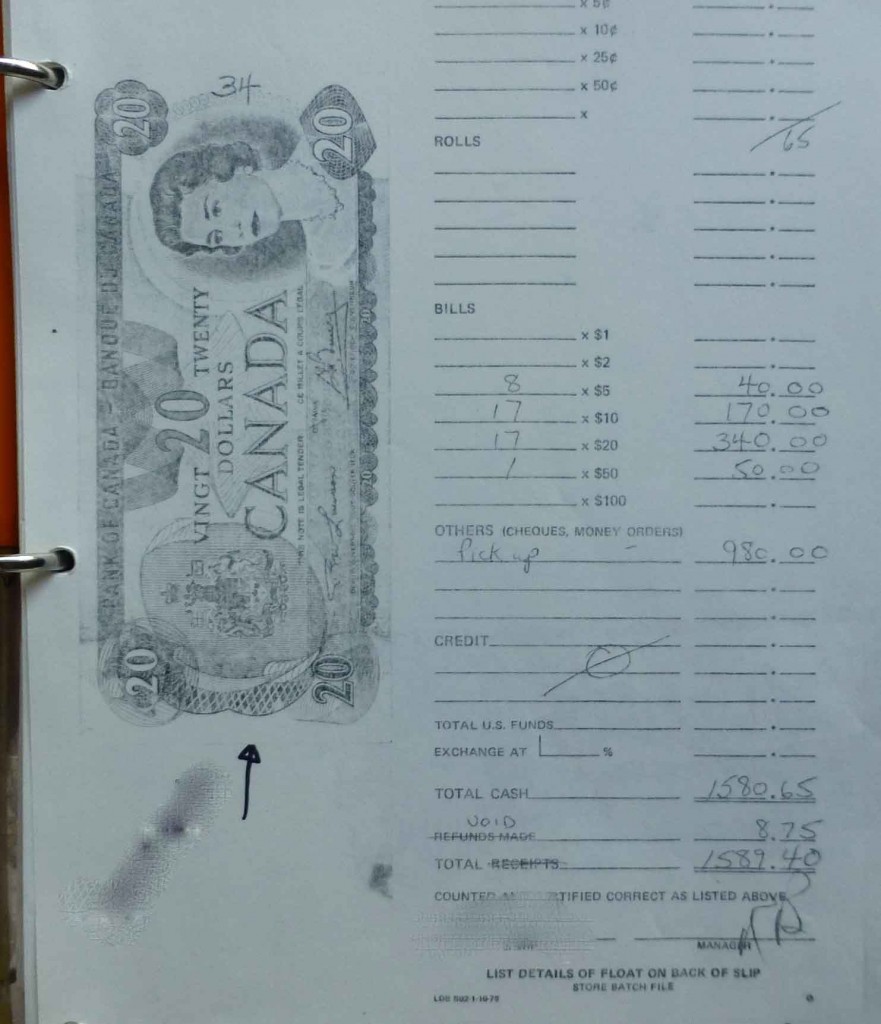 with the audit copy of the ticket attached.
with the audit copy of the ticket attached.
Both the ticket and cash were seized and on one $20 bill we noted the number “34” printed on each end. It was interesting to note that while Dube gave his own name for the ticket, he signed it (it had to be signed in those days) with the name Willy Wonka. Why? We had no idea, perhaps to many tokes over his short life.
The next day Bond and I took the bills to the Brentwood Liquor Store and the manager immediately identified the bill with the printed “34’s” as having been one of thirty-four $20 bills included with the stolen money. He recognized one set of numbers as having been written by himself and the other by one of the clerks. To see how meticulous the cash count was and why the manager recognized the printing on the bill check out Footnote #1.
Photo (file). On this bill, the one “34” (top) is clearly visible, the other, at the bottom, was faint in the copy, but readily visible on the original. The count slip to the right is from the Air B.C. count (17 twenties). The count slip from the liquor store would show “34” twenties as processed and part of the money taken in the robbery.
The store copy of cash count receipt was seized for identification purposes. While this was excellent evidence, the fact Dube was not in the city at the time of the robbery excluded him and even a charge of possession of stolen property would be pretty thin. We surmised someone, likely Dillinger, but possibly Wonka, had given Dube the money to purchase the ticket.
As evidence was still flowing to bolster a solid robbery case, it was decided to continue monitoring the phones and maintain periodic surveillance in hopes of connecting the rest of the dots. However, a day later, an outcall from the residence made by an associate of the gang, one Sean Penn, to a number in Vancouver inquiring about buying several .38 Special revolvers, changed everything.
The next day Penn phoned Wonka and asked if they still needed the radio to which Wonka replied “yes”. Dillinger then came on the line and asked Penn about the guns and Penn stated he would pick them up in Vancouver in the next day or two. The cost was $500 for all five. That same day Wonka phoned K-Mart looking to buy a scanner telling the store clerk it was for his (Wonka’s) father. Clearly, things were changing fast. With the intercept orders ending, RCMP Constable John Roung and I went to work applying for wiretap extensions with Roung working on the Wonka order and I, the Penn line. Writing that order would be my first since joining the squad a few months earlier.
As the original file now morphed into new territory our OIC, Inspector Hempstead, brought the matter before the JMT and an extension was approved the same day. The great thing about the JMT organizational structure was the ability to move quickly up and down the chain of command even in a matter of hours if needed.
7. The Ferry Robbery Conspiracy Begins
While the wiretaps provided good information, surveillance filled the blanks and those blanks proved mighty interesting. The day after the money pick-up at the airport, Constables Roung and Gilbert followed as Dillinger and Wonka drove to the Swartz Bay Ferry terminal. After parking, the suspects spent an hour wandering about making notes and 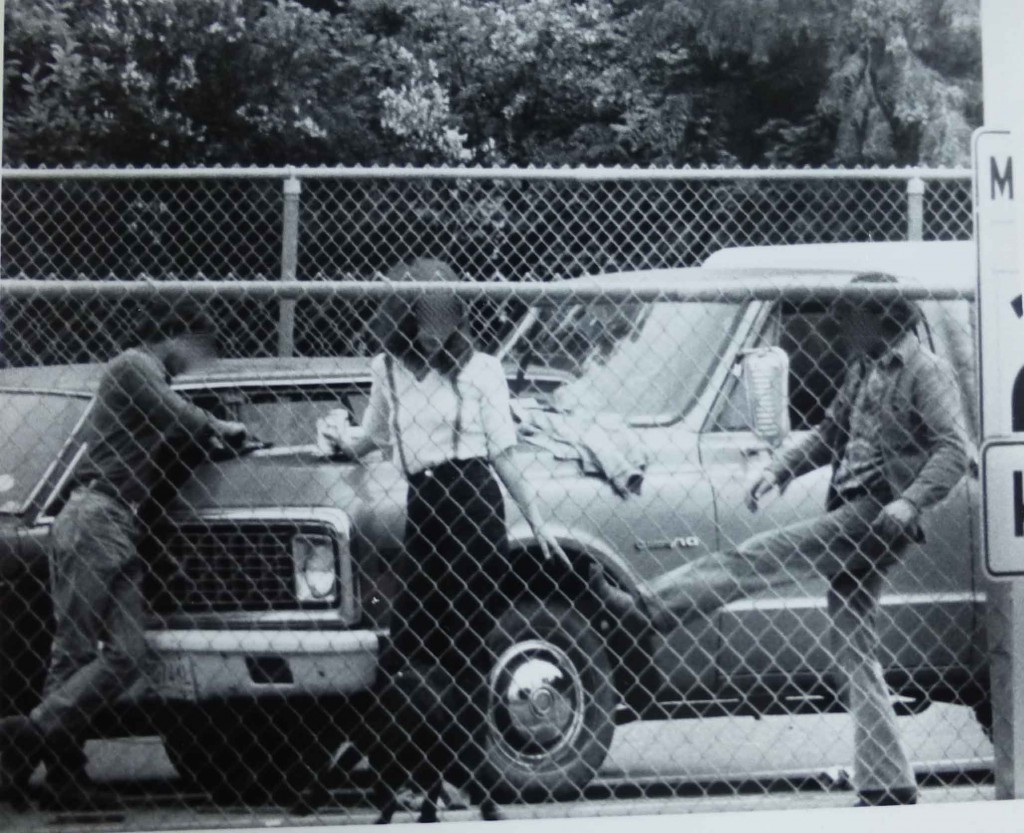 sketches. The same day Det. Bond and I observed Penn and Doe checking out the side roads around the terminal.
sketches. The same day Det. Bond and I observed Penn and Doe checking out the side roads around the terminal.
Photo: Taken from OP using telephoto lens.
Over the next few days we observed as various members of the gang drove to the Ferry Terminal where they spent several hours watching the movement of the tollbooth operators and other employees. Of particular interest to the group was the arrival and departure of the Brinks Armored Car. As there was always a lot of foot traffic around the terminal area, the movement of the suspects never drew any attention.
However, to provide a better vantage point for police, Det. Bond and I checked out properties on the west side of the terminal. After vetting the owner of one property, we made arrangements to set up an observation post (OP) in a wooded section that provided excellent coverage of the terminal parking lot and administrative building area. We were able to set up a tripod and over several days grabbed dozens of photos of the gang as they went their planning sessions.
Our best guess was a plan involving the robbery of a Brinks car as it made the pick-up from the administrative building. The gang now had the scheduled times for the armoured car and how the cash moved from the booths to the administration building. From this point, the watchword was caution, for, as yet, we had no idea when the robbery might take place.
8. Garbage Day 2
After making the bi-monthly pick-up and heading back to the CSP office this search revealed the following items:
1. An ‘accounting sheet’ with the names Mona. John and Willy. This was clearly our three main suspects in the robbery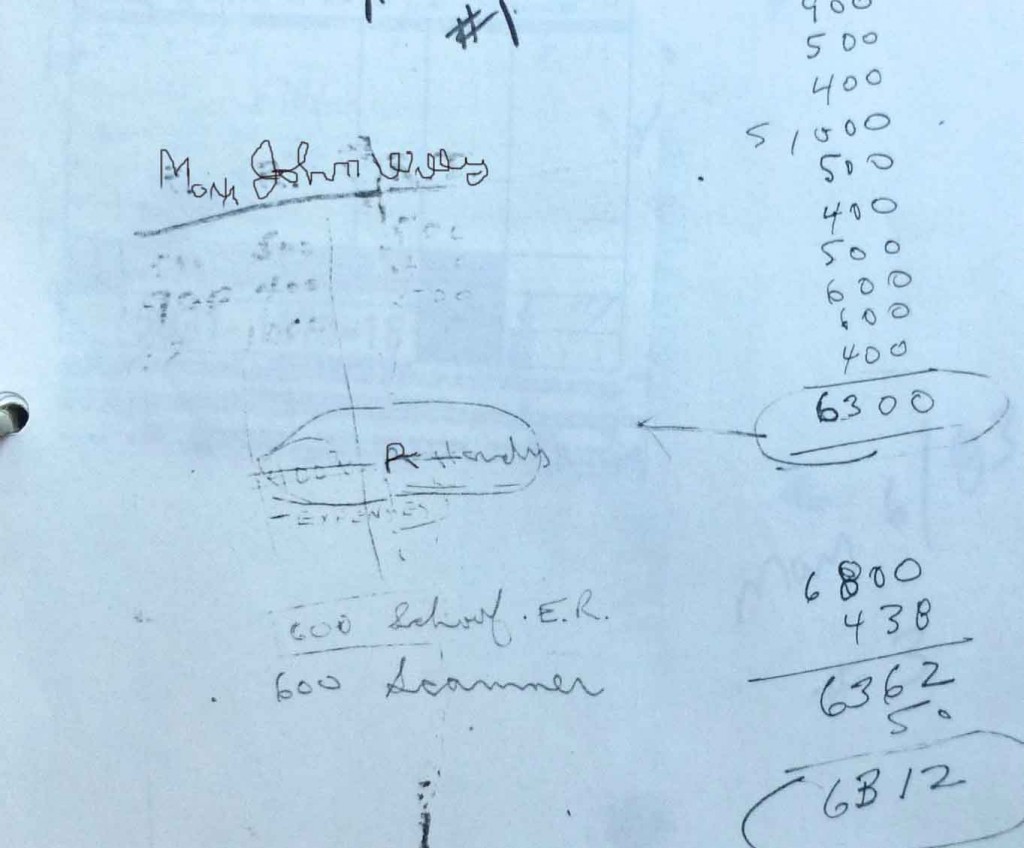 . The total count was $6300 and, as well, included a list of expenses; Port Hardy (cost of getting rid of the pothead); School fees for Mary Jane and $600 for a scanner. This brought the total within the range of that taken in the robbery.
. The total count was $6300 and, as well, included a list of expenses; Port Hardy (cost of getting rid of the pothead); School fees for Mary Jane and $600 for a scanner. This brought the total within the range of that taken in the robbery.
2. A torn page of lined foolscap with handwritten notes (photo in footer):
-
- 454 divided by 32 equals 14½ ozs, 1 pound equals 20,000
- coveralls, gloves, walkie-talkies
- check about caps at 4251 Blenkinsop, 477-6964 (note: this related to call #23 made by Mary Jane Doe to Web and Trace (a local blasting company) in which she inquired about blasting caps. The man at Web and Trace told her she could buy them and powder – all she needed was a driver’s licence. Mary Jane wanted a box of 50 caps and also inquired as to how long they would take to go off.)
- notes on balance sheet – scanner and lighter adapter $ on antenna.
3. A half dozen receipts from the Brentwood Bay Liquor Store (the store was quickly getting their money back). Between the Liquor Store, the Brentwood Bay Inn (comment below) and a few other local businesses, the gang was keeping the money local – no off-shore bank accounts for these folks.
4. Several other items of unknown interest at this time.
During this same period there were several calls related to purchase of dynamite and the use of blasting caps; about having purchased and tried the walkie-talkies and comments that a range of one mile was needed. Members of the group also spoke of having access of a pound of gold – melted down – worth $20,000.
9. Surveillance Humour at the Brentwood Inn
Over the years, surveillance always provided humour of one sort or another, either among the police members or those we were surveilling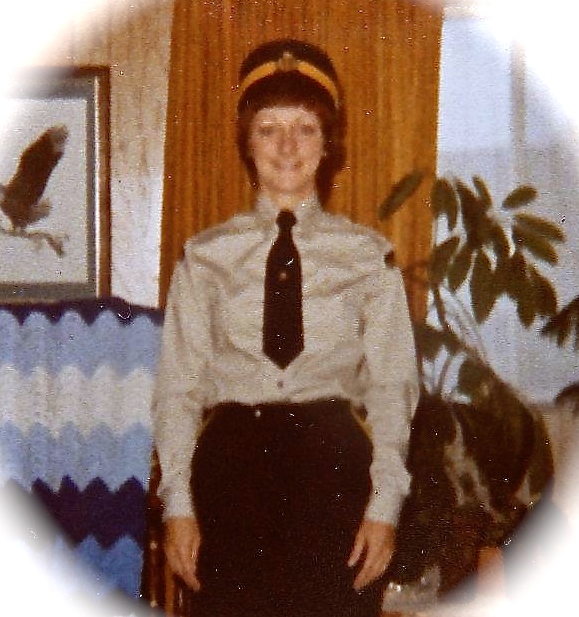 . One day when a phone call indicated the gang was having a special dinner at the Brentwood Inn, we decided to cover off the meal to see if anything interesting popped up.
. One day when a phone call indicated the gang was having a special dinner at the Brentwood Inn, we decided to cover off the meal to see if anything interesting popped up.
At the time Lynn Davis (later to become Lynn McNeill) was employed at the Oak Bay Police Office as Personal Secretary to the Chief Constable. Lynn came to Oak Bay from the Colwood RCMP where she worked for a short period as a Civilian Dispatcher after having joined the force as a Civilian Member in Campbell River.
Lynn was also a member of the RCMP Reserve (photo left, c1980) and along with her longtime friend, Cathy Gordon (photo below right, who would later to become the wife of Colwood RCMP member Constable Gordie Dash), the two young, single women became accustomed to police life while serving in the area of Campbell River and Comox.
Before joining Oak Bay (and meeting her future husband), Lynn spent several months touring the Interior of the Province as a Special Assistance to the IBCCS (Interior British Columbia Communications Team) and at one point helicoptered to the top of 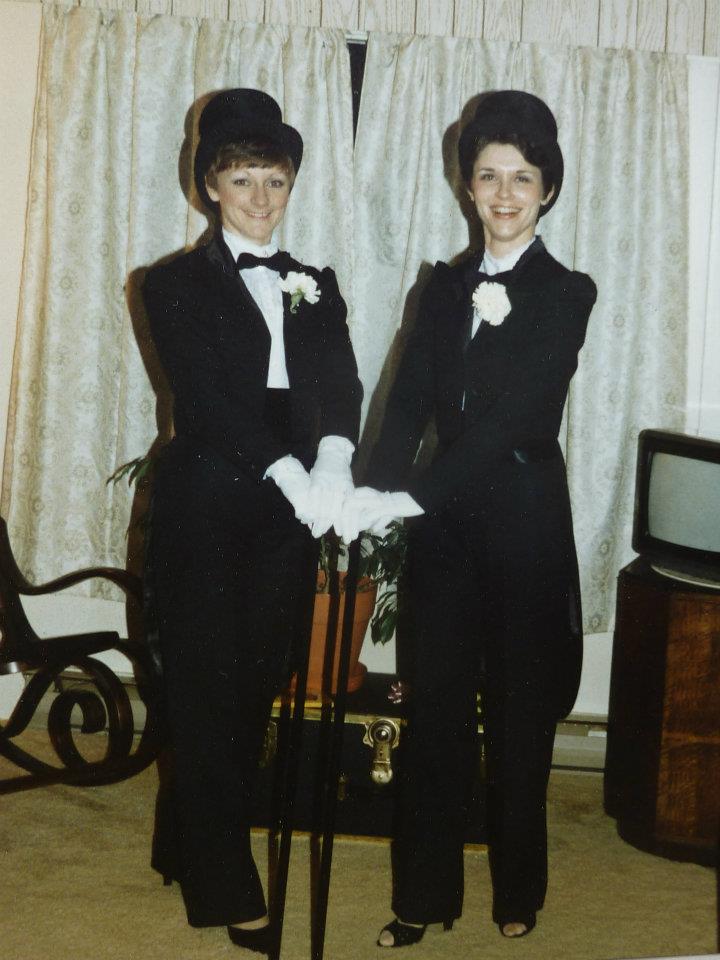 Mount Robson while installing part of a new communication system for the force. Lynn’s primary job was attending dozens of Interior RCMP Detachments and instructing members on use of the new radio system.
Mount Robson while installing part of a new communication system for the force. Lynn’s primary job was attending dozens of Interior RCMP Detachments and instructing members on use of the new radio system.
After coming to Oak Bay, Lynn occasionally accompanied me on surveillance when doing close quarter checks (e.g. restaurant walk-throughs, beer parlours, lounges, etc.). It was always less conspicuous than when a man or woman wandered in alone.
Photo (c1980): Lynn and Cathy as they get ready to escort a young man to his going away party just before heading to recruit training in Regina.
Back at the Brentwood Inn Lynn and I were using the CLEU surveillance van, but the only good OP by the Inn was marked “Residents Only”, so we took our chances. As the van had a periscope in the back with a camera mount we were able to get several photos of the gang as they arrived. A little later Lynn and I entered the lounge area, had a beer and checked out the group. It appeared the dinner was only for the regulars and likely a planning session. Nothing of particular interest popped up inside so we returned to the van.
As we awaited the gang’s departure, someone banged on the passenger door. We hadn’t noticed any of our suspects come out, so I got out and spoke to a man who identified himself as a local resident. He complained about my parking in a ‘Residents Only’ zone. Not wanting to identify myself as a police officer, yet wanting to keep the spot for another hour, I quietly pulled the guy aside, told him I was on a date with this new girl and that we had just finished dinner, had a bottle of wine “and you know…” (wink, wink, nod, nod). The guy was quick on the uptake, winked back and said something to the effect of ‘take your time buddy’.
After climbing back in I told Lynn it was just a neighbour and it was OK if we stayed, but never told her what I had said to make it OK. After a few minutes elapsed I stretched out, put my feet against the side bench telling her I had a cramp in my leg. As I pushed back and forth the van started to gently rock. I did this a couple of more times over the next hour and she thought I was just being weird (as usual). When the gang left, we grabbed a few more photos and then on the way home I told her how I had got the neighbour off our backs. She punched me, called me a not nice name and we still chuckle about that little interlude in our pre-married life.
Back on the case, it was around that time Mona Lisa dropped off our radar. We all had the feeling she was in well over her pretty little head, but not sure whether she just had falling out with Dillinger or whether something more sinister happened. We spent a day in Vancouver checking around her apartment, but nothing was found, her car was not located and the phone line went silent. We knew Dillinger was a dangerous man, but there was nothing in any conversation or observation to suggest he might have been responsible for her disappearance. He had made a couple of calls to her residence, but when no one answered, he stopped calling. To begin poking deeper into her activities would clearly jeopardize the investigation, so the decision was made to continue as planned.
10. The Royal Bank in Brentwood, a Possible Target
While the gang possibly had access to some gold, it appeared they were still struggling with money problems. Perhaps they donated a little too much back to the liquor store and the rest may have gone up in smoke at those late night parties. But, for our crew, things took a possible turn for the worse when Dillinger, Wonka and another were observed wandering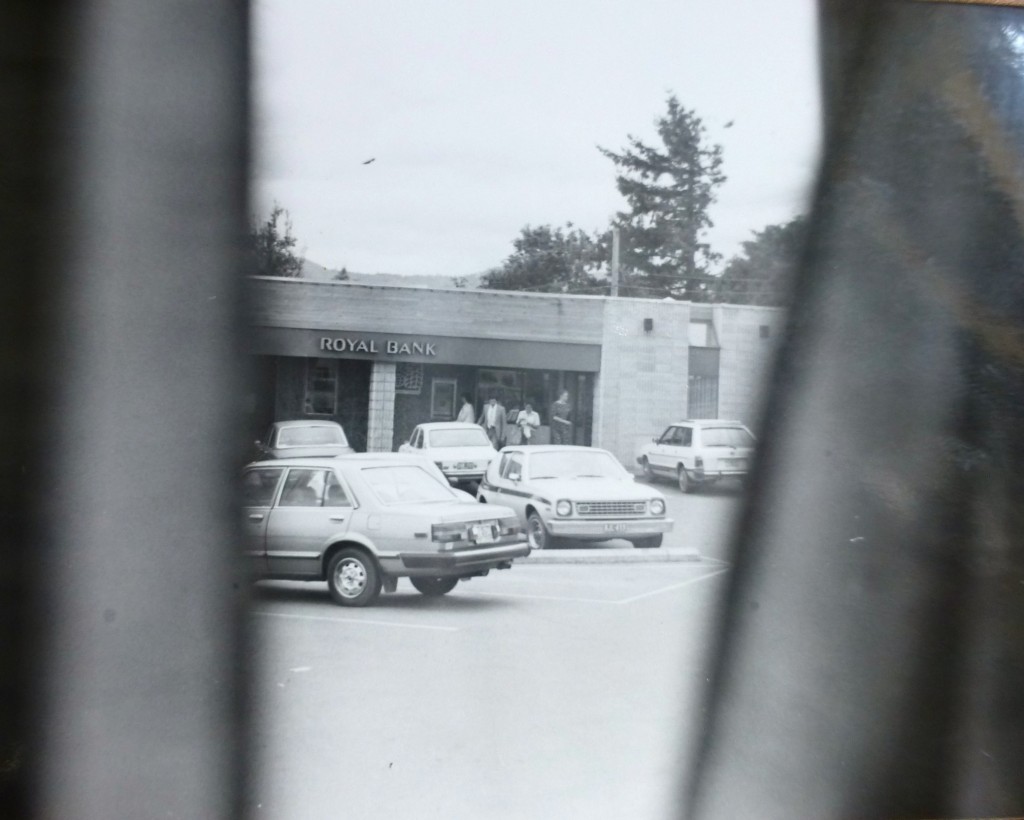 around the Royal Bank in Brentwood. That he was an experienced bank robber having knocked several outlying banks in the lower mainland, the RBC would be his cup of tea.
around the Royal Bank in Brentwood. That he was an experienced bank robber having knocked several outlying banks in the lower mainland, the RBC would be his cup of tea.
Photo: Taken from a surveillance van.
As we were reasonably certain the group was in possession of several handguns, two or three rifles and probably a stash of dynamite and other equipment, the threat of a bank robbery to grab a little extra cash was real and immediate.
The RCMP members in our section were getting significant blowback from a senior RCMP Inspector at HQ who was monitoring the progress on the Ferry Conspiracy and, although he was not attached to the JMT, he wanted the gang taken down immediately. If that happened we would likely be left with a rather shaky robbery case. To his credit, Inspector Hemstead stood his ground and along with other members of the JMT, cooler heads prevailed and the surveillance was allowed to continue. But, just in case it all blew up, we doubled up on the RBC security during banking hours.
Det. Bond and myself were assigned to an inner perimeter stakeout in the banks parking lot. Using a borrowed camper truck with shotguns at ready, our instructions were clear – if any member of gang happened to get through the outer perimeter and showed up in the parking lot, they were to be immediately arrested at gunpoint.
It was a tense time and while the gang was well covered with several CLEU and CSP units, it was hard to predict how things might evolve given Dillinger’s dangerous offender history. A running gun battle was the last thing we needed. I rather think our Inspector (Einer Hempstead) was more than a tad nervous as he and his partner had at one time been in a running gun battle with a couple of bank robbers in a chase that extended from downtown Victoria, out the Peninsula to North Saanich and then by boat into the waters of Brentwood Bay before the robbers were apprehended. I think Inspector Hempstead was shot in that little escapade. Perhaps someone who knows this story firsthand could help me make any needed corrections.
Following the second day of full coverage, phone calls and other movements suggested the bank was off the list as it appeared Dillinger had come up with several thousand in seed money from an associate in Vancouver. A greatly relieved crew pulled back and the Ferry Terminal and Brinks Armored Car were again given top billing.
11. Decision Time after Garbage Day 3.
As the days slipped by, it seemed increasingly likely heist would go down on the May long weekend, although there was no evidence this was a sure thing. It seemed likely as it was a time when cash flow at the terminal was usually at a maximum and in excess of $200,000 could flow through the system as cash was king and credit cards were still a second or third choice for many customers.
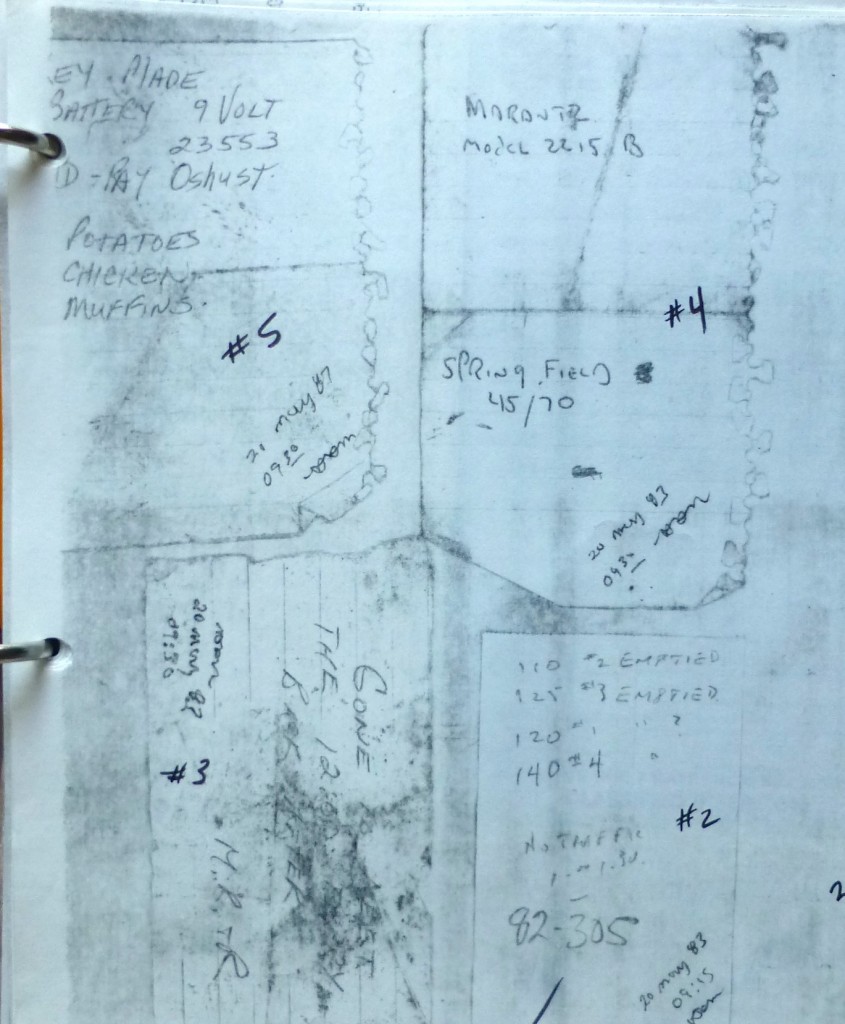 As we still had no idea where the gang might have stored their weapons and dynamite, this was of great concern. Given the diversionary tactic used for the liquor store robbery, it seemed certain the dynamite would be used to create a sizeable distraction. However, we had no idea where or where that might be, and with the number of weapons now believed to be in possession of the gang, there was the potential of a small war breaking out if things went sideways.
As we still had no idea where the gang might have stored their weapons and dynamite, this was of great concern. Given the diversionary tactic used for the liquor store robbery, it seemed certain the dynamite would be used to create a sizeable distraction. However, we had no idea where or where that might be, and with the number of weapons now believed to be in possession of the gang, there was the potential of a small war breaking out if things went sideways.
Just before the week-end the garbage pick-up was only marginally productive, with a few liquor store receipts, on one of which the Brinks money pick-up times was noted and another suggesting two more rifles, a Murants model 2215B and a Springfield 45/70 were now in possession of the gang (note photo left).
With the amount of weaponry increasing by the week, the decision was made to pull the pin and arrest the subjects if they began to move toward the ferry terminal over the long weekend. We would take a chance that enough additional incriminating material would be found in the residence or that, as in this type of case, one or two of the lesser gang members was willing to roll over and provide evidence against others gang members.
Well, you guessed it. The gang remained absolutely still through Saturday, Sunday and Monday. No one moved and no intercepted calls indicated they were about to move. Our entire crew was at ready, overtime was racking up by the hour and management was becoming increasingly anxious. The Inspector from RCMP HQ, who had now gained a seat with us, was becoming increasingly agitated. When the last ferry departed on Monday afternoon and all was quiet, the decision was made to do the takedown the next morning, May 24, 1983.
At a final meeting in the CSP office that Tuesday, all members were briefed and assignments made. Because it was likely weapons and explosives were being held at the residence, it was decided to make the arrests, if possible when the main gang members were split up and driving in rural areas. Det. Bond, Roung, Gilbert and myself were assigned to take down Dillinger and others who might be in his company. Immediately after his arrest, others would be picked off as quickly as possible.
Early that afternoon a phone call indicated Dillinger, Wonka and Doe were heading out from the residence. Close in surveillance picked up on Dillinger’s vehicle which was now sporting a set of stolen licence plates. As the suspects drove through a rural area of south Central Saanich, two CSP marked units and two CLEU unmarked units closed in and made the stop.
The three occupants surrendered without incident. No weapons were found and all were taken to the Central Saanich Police for processing and then lodged in Victoria Police cells pending a first court appearance the following day. Others were similarly taken into custody without incident. It was a rather anticlimactic end to a case that had run about five weeks from beginning to end, but there were still dozens of loose ends to cover off.
Oh, and a humorous event took place during the takedown, for which I was to pay the price in ribbing. When we initially left the Central Saanich office, I was assigned to travel with two uniforms (Constable Jack Hill and one other) in the primary marked unit that would do the pullover. I jumped in the back (the prisoner’s seat) with my shotgun and felt quite secure as there were no door handles or window winders on the inside and, as well, a Plexiglas screen between the front and back that completed the seal. During the hectic moments when the suspects were being taken down at gunpoint, I remained locked in the prisoner’s seat and was not released until the prisoners were handcuffed.
12. Search of the Residence
After the search warrant was issued Bond, Roung, Gilbert and a few others along with myself, attended the residence and the following items seized:
1. Four Portable radios (reference calls 21, 22 and 25)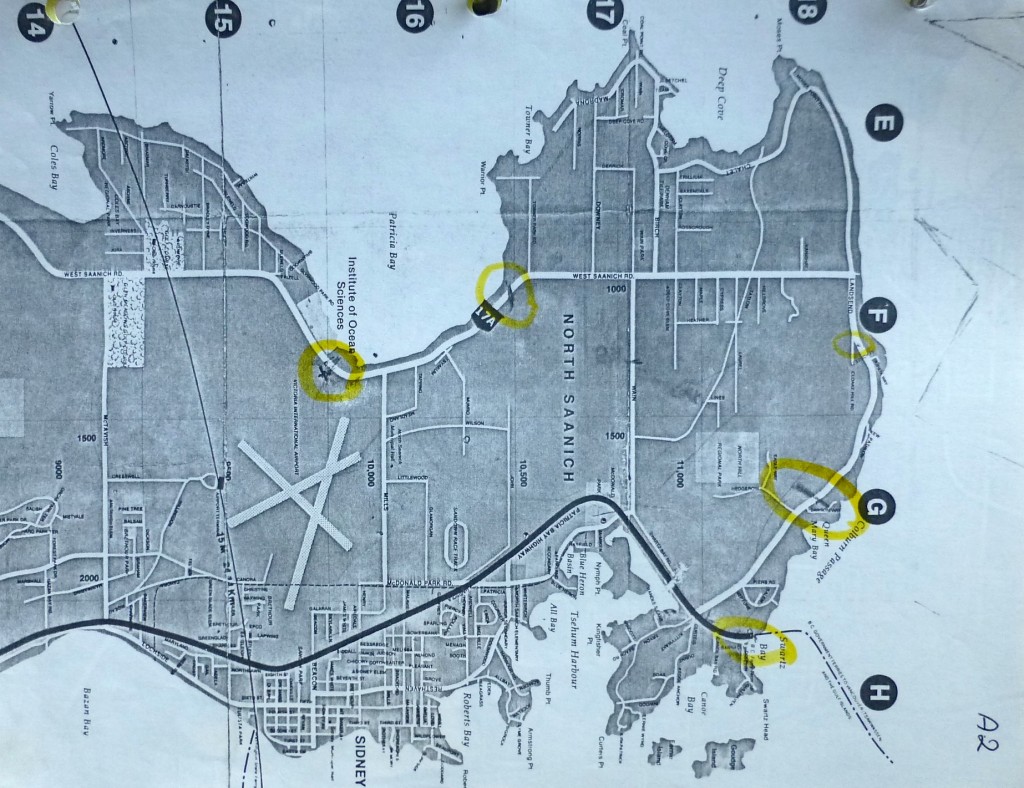
2. Map of North Peninsula with yellow circles at (right and footer):
-
- B.C. Ferry Terminal
- Two circles on Lands End Road (surveillance previously showed gang members checking out various side roads and waterfront access)
- Ocean Sciences Complex
- Commerce Mall with RBC Branch and Trafalgar Mall
- Target residence
3. Envelope with return address of Employment and Immigration date stamped one week after the Liquor Store Robbery.
4. Handwritten on front:
(My Note: Over time sticks of dynamite will “weep” or “sweat” nitroglycerin. Crystals will form on the outside of the sticks causing them to be even more shock, friction or temperature sensitive. This creates a very dangerous situation. While the risk of an explosion without the use of a blasting cap is minimal for fresh dynamite, old dynamite is dangerous (Wikipedia)).
-
- Is one cap enough?
- How close to store caps
- How much current for spool
- Remote Control
5. Diagram of Swartz Bay Ferry Terminal including passenger area, washrooms, offices, radio frequencies for terminal and golf carts.
6. Small sheet of paper listing
-
- Cost of boxes 17½ X 11 7/8 X 6 ½ ($175.00)
- Municipal Maps
- Gloves, coveralls, stainless wire
- Phone numbers of various people
7. Sheet of paper listing various items
-
- Police Codes (e.g. 10-29, 10-7, 10-6, etc.)
- “Plant Hindsight Score V (???) 10 spd Wed P.M
- Small wagon drops off to pick up boat
- Van picks up boat driver and to sting (?)
- A.B. detonates after Armie goes by (10 min)
- A.B. leaves after Van goes by
- Boat to Agua
- Fisherman fish until 5:00 pm
- Go Home
- Try scan from small wagon
- Try walk and talk from P. Bay to surveillance
- Try to detonate from Pat Bay to surveillance
8. Ten pages of radio frequencies and 10 codes
9. 12 gauge shotgun and case
10. Small notepad
-
- caps, boat and racks, pump
- gloves (2), hat, coveralls
- bike and accessories
- Dirt Bike
- Helmet
- Mun. Maps
- Harness
- Dent ________
11. Envelope with diagram on front
-
- diagram appears to be around the intersection of Raven Croft
- (note: Raven Croft is one spot circled on larger map) code 10-72 B&E Loc 2090
12. Various radio equipment
-
- Realistic scanner (20 channel 2020)
- AM-FM scanner, Model 20-112, Serial 2-048691 with car adaptor
- 2 audio source research speakers (back) with three clips on back and silicone on the back (later identified by the owner as stolen items)
13. One 30-06 Alpine Supreme, bolt action, rifle with 4X banner scope by Bushnell in a leather sling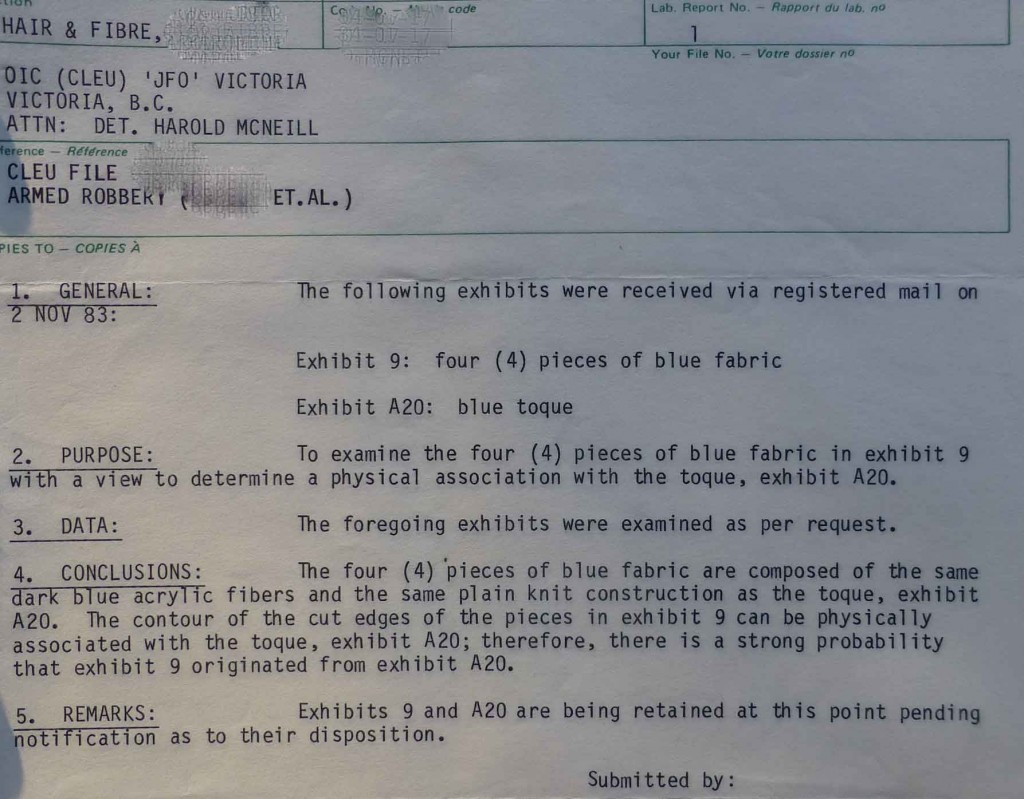
14. One .308 Winchester Remington – Mohawk 600 S/N 6948200
15. One .22 calibre Cooey Model 60 repeater
16. Blue Balaclava (see crime lab report, photo right)
17. Two toques (one orange/green, one orange/brown)
18. One black leather side holster
19. One set of handcuffs
Although we thoroughly searched the residence, surrounding the property and other locations, we could not find a trace of the five handguns or the dynamite. All the accused lawyered up so no further information was forthcoming from their end.
But, you might ask, what happened to the elusive Ms. Mona Lisa. Shortly after the arrests, a telephone call suggested she was back at her apartment in West Vancouver. The West Van PD was alerted, picked her up and lodged her in their cells pending pick-up and transfer back to Victoria.
The following charges were immediately laid against John Dillinger, Willie Wonka and Mona Lisa regarding the Liquor Store Robbery:
- Steal money while armed with an offensive weapon;
- Using a firearm while committing an indictable offence
- Theft of a motor vehicle and contents
- Possession of stolen property over the value of $200.
Some time later, a single charge against John Dillinger, Willy Wonka and Mary Jane Doe consisted of conspiring together and with other persons unknown to commit an indictable offence of robbery, to wit, to rob a sum of money the property of the British Columbia Ferry Corporation Terminal at Swartz Bay near Sidney, County of Victoria, Province of British Columbia, contrary to the Criminal Code of Canada.
13. Preparing the Case
While the investigation only took five weeks from the time of the first intercepted call connecting the group to the liquor store robbery, it generated a pile of material that needed to be catalogued and prepared for court.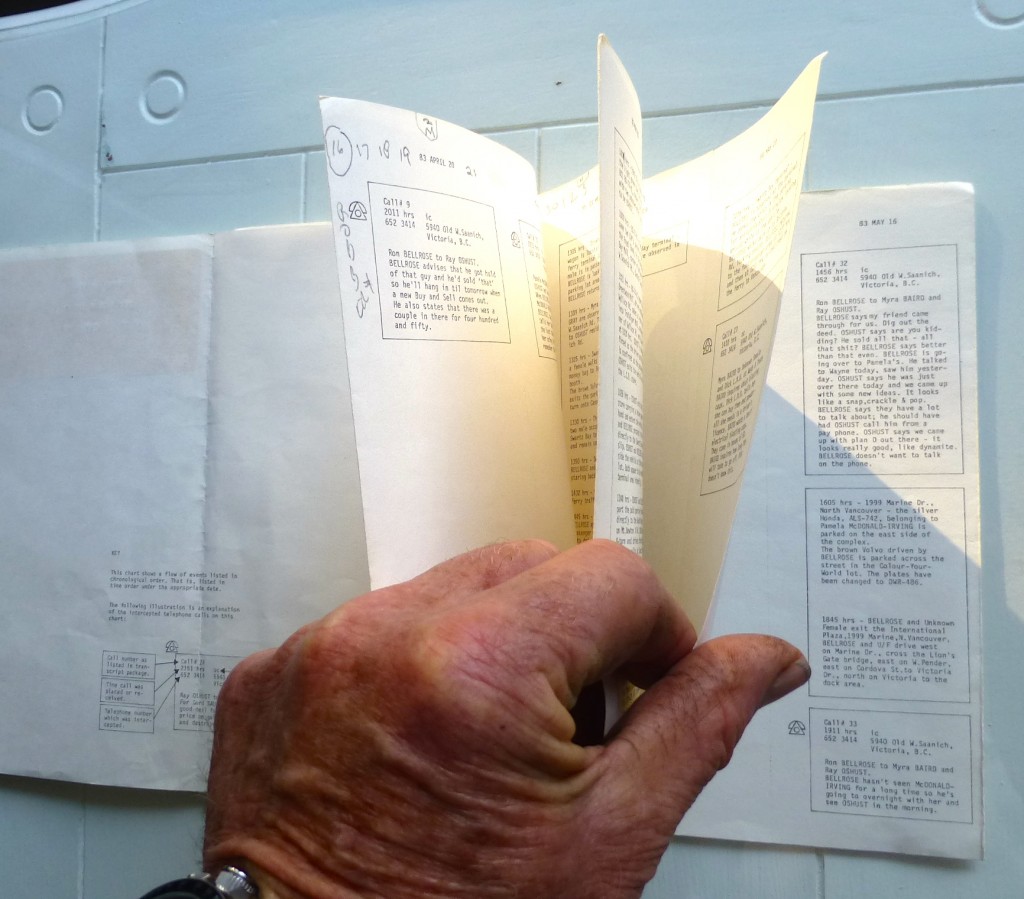
As wiretap conversations made up a significant part of the evidence, verbatim transcriptions had to be prepared, catalogued and placed in binders for distribution to the accused persons, defence lawyers, prosecutors and others. It also took the better part of two weeks to work through various documents and property lists to organize the connections between those items and relevant phone calls, exhibits and surveillance notes of various officers and civilian witnesses. While I prepared the initial full typewritten list of items expected to be used, Constable Roung added to that list and made an excellent chronological flow chart for use by the prosecutors when presenting their respective cases.
Photo: The spreadsheet made by Cst. Roung, continued for 35 pages. The sheet was painstakingly made at a time when computers were more of a novelty than an essential piece of equipment as in today’s police office.
While we could connect the main gang members to the robbery and ferry conspiracy, there were still holes in the case that would best be filled by turning one of the accused into a crown witness. Several names were discussed and tossed aside as not having a comprehensive knowledge of the leader of the gang, John Dillinger.
The weak link appeared to be Mona Lisa, whose actions in the robbery was limited to the phone calls she made looking for balaclavas and then placing the diversionary call to the Central Saanich Police. Those two items and her association with the Dillinger were sufficient to convict her as being a party to the offence. That provided the leverage we needed to possibly turn her into a crown witness. The fact that we had later learned she had skipped town and laid low in California while the ferry robbery plans were being developed, made for an easy decision. As far as we could tell, prior to the liquor store robbery she was squeaky clean, was a divorced mother with two young children and, as sometimes happened, had been drawn into an affair and later a crime by a cunning and dangerous man.
After some preliminary discussions between ourselves, the prosecutor and her lawyer, Ms. Lisa attended the Oak Bay Police office and provided a complete statement. Although Dillinger was being held in custody, his past and present criminal connections suggested he or an associate might seek to intimidate Ms. Lisa once word was out that she had turned on the gang. Constable Roung made an application to have the woman placed, at least temporarily, in the witness protection program until the court proceedings were complete, then longer if necessary. In the program, she was provided with a modest living allowance and moved to a temporary location out of the country.
In addition to a full statement and as a further show of good faith, she took Constable Jack Hill and me the exact spot where she had tossed the starter pistol in the ocean off the Sidney waterfront. On January 24, 1984, some eight months later, an RCMP diver was called in and not only did he recover the starter pistol, he also recovered 3 spent and 5 live cartridges. Given the generally violent nature of the rip tides in the waters off the coast of Vancouver Island, it was an exceptional find.
Following is a few key items included in Ms. Lisa’s statement:
Met with John during week previous to the liquor store robbery and he indicated some plan underway – would pay off well financially or else it would be the end of everything. He was leaving for the Island the next day. I followed in my own car later that day to meet him.
John made all the plans on the liquor store robbery telling me the only way I could be connected was if he or Willy divulged my identity. John fully expected we would get upwards of $100,000 in the robbery as the bag was always stuffed. He stole the get-a-way van at the ferry terminal and Willy was the driver for the robbery. I was present when discussions took place about acquiring guns and when they started planning for the next robbery. They had much bigger things in mind.
I was also present when discussions were held about obtaining dynamite and other items for the ferry robbery. At that meeting one of the people stated the police had rented an apartment next to his so they could keep an eye on him. Still later someone stated the dynamite would be used to blow up a car or phone booth. They had a plunger that apparently would be used to set off the dynamite. John had obtained a large handgun, he called it a magnum, the one he used for the liquor store robbery. Sean showed us some eavesdropping equipment he said he could hear through walls with.
A couple of days before the robbery John and I made calls looking for balaclavas, but couldn’t find any. Ron purchase two blue toques I cut holes in them for the eyes. Ron also bought some leather driving gloves at the time he purchased the toques. I went to Waddling to test the starter pistol and practice the call.
The night before the robbery, John plunked down a $100 bill to buy a bottle of Dom Perignon to celebrate. The next morning John went to the ferry terminal and stole a van. He also stole two other sets of licence plates. After the robbery John complained about Willy being a lousy driver as he had ripped the door off the van and John nearly fell out. John was very disappointed there was only about $7000, but on the other hand he was happy to find his hundred-dollar bill was included in the cash.
I later asked John whether he would have used the gun and he assured me that if it came down to him or the liquor store manager, he would shoot. It was at that point I realized just how dangerous John was and that I needed to put some distance between the crew and myself. That was went I decided to leave for California for a couple of weeks.
John gave Dube the money to fly to Port Hardy as he, John, just wanted to get rid of the man as soon as possible so they could get on with planning the ferry robbery, then he later told me about his ingenious plan to rob an armoured car. His plan was to steal a van with back opening doors. They would then back up to the armoured car, fling open the doors where they would have a machine gun mounted. He said it was an ingenious idea used to rob an armoured car back east. He was visibly excited and mentioned that on the long weekends there was a lot of money at the ferry terminal.
When I decided to leave and was heading back to Vancouver, John decided to come with me and while there we went out for dinner a couple of times and on one occasion I went with him while he purchased three balaclavas. One was orange I think. When he finally left to go back to Victoria, I packed up and headed to California. I never told him were I was going.
When I got back I spoke to John on the phone and he said all was good to go and that I should just sit tight at home. He said that after it was over they would all hunker down for a while, but once things cooled we would never have to worry about money again, that we’d even go to Paris on a Concord. He said they had a stash of dynamite and several guns including a very special Belgium handgun. He referred to the others as his “up-coming guerrilla friends”. I wanted no part of it so decided just to keep quiet and not see him. That was the last time I saw John until we were arrested.
Signed Mona Lisa.
14. A quick trip to Port Hardy
As part of follow-up interviews, I made a quick flight to Port Hardy to interview Scooby Dube. As a special treat, it was the first time I had a chance to catch a ride on a Beechcraft A90 (Super King Air) the RCMP’s first venture into turboprop. At the time I had several hours as the pilot in command on the Victoria Flying Club’s, Beechcraft Musketeer, the granddaddy of the King Air. The Super King Air was a flying treat, and as an added bonus the weather was perfectly ‘shitty’ in Port Hardy, so I was able to watch the pilot execute a full ILS (Instrument landing) approach to the airport.
I would be in Port Hardy less than two hours as by prior arrangement the Port Hardy RCMP had picked up Dube and brought him to the Detachment Office to await my arrival. As expected, Dube was a basket case by the time I spoke to him as he was certain he was being charged with armed robbery. The best we could get from him, and it was an important point, was the fact that Dillinger had given him the twenty-dollar bills used to pay for his airfare. Dube even watched as Dillinger took those twenties from his wallet. Circumstantial? Yes, but in the context of other evidence, was another nail in Dillinger’s coffin.
15. Case Conclusion
After all the paperwork was submitted to the Crown on both cases, our crew devoted full attention to other cases, some of which were running simultaneously to this file. The East Sooke and Victoria “Cultivation and Trafficking in Psilocybin” (Magic Mushrooms), remained hot, so that kept Detective Bond and myself busy in East Sooke. It would be the first time either of us engaged lock specialist to gain entry to a building and taking several photographs of an ongoing grow-op.
It was likely one of the harder cases for the lock guy, John Deering, as we had to bushwhack our way in through acres of forest and undergrowth 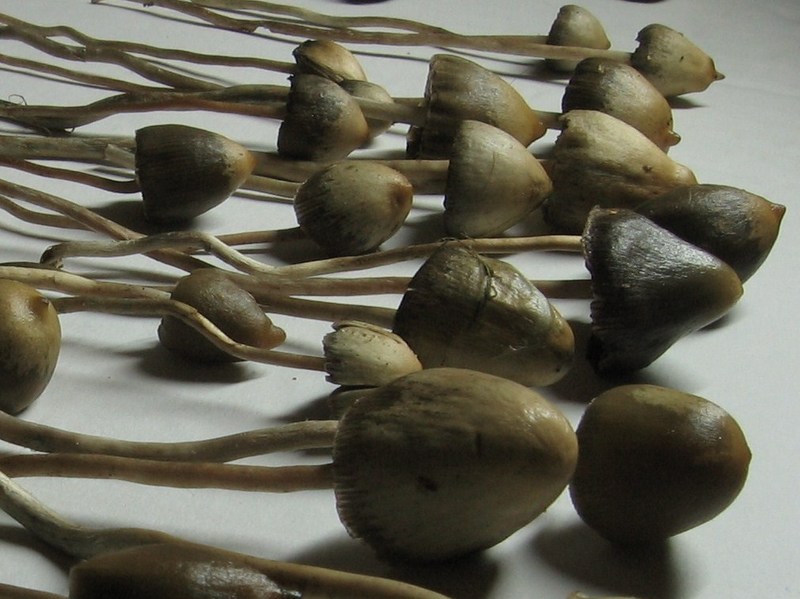 in the dead of night. Even though Doug and I had made that trip before (several times in the daylight), it was hard slogging at night that was completed for the most part without a light as the residents were present when we made the entry.
in the dead of night. Even though Doug and I had made that trip before (several times in the daylight), it was hard slogging at night that was completed for the most part without a light as the residents were present when we made the entry.
While ‘shrooms’ were in seasonally plentiful supply in the forests of BC, they were mostly harvested by a diehard hippy community for personal use (I suppose they were the original “Get Fresh” people).
Photo (Web Source). Wild shrooms. Somehow those little guys look vaguely familiar. I can see why it might blow someone’s mind if they ended up in the wrong place.
For commercial purposes, grow operations provided the best bang for the buck and the people we were tracking, did it in grand style. Part of their operation even served as the subject for a doctoral thesis on the commercial production of psilocybin.
The operation was of sufficient sophistication that suitcases filled with dried mushrooms were being transported by hired hands to Edmonton, Calgary, Saskatoon and Winnipeg on a regular basis. The story will be written at some future time and will include a connection that took me all the way back to my time as a Crash Rescue Fireman with the US Air Force in Cold Lake. That case was additionally significant in my life as it resulted in a major conspiracy trial involving seven co-conspirators persons, seven defence lawyers and ran for several weeks through the late spring and summer of 1984. The trial nearly caused Lynn and I to postpone our wedding plans for July 27 in Cold Lake as I was only released from court the afternoon before we were to leave.
As there was so much going on with active cases, it all but slipped from our minds that accused people in the Brentwood Liquor Store robbery and Ferry conspiracy cases, all plead guilty to the main charges. As time permits I will check the Times Colonist records to see what sentences were handed. Perhaps another member who reads this story can let me know the outcome.
Harold McNeill
Detective-Sergeant (Retired)
Notes
1. Bill Thistle, the Affable Con Artist
On one occasion while I was in uniform fundraising for some charity in front of the Fort and Foul Bay Liquor Store, Bill came out and borrowed $20 “as he was a little short of change at the moment.” A few weeks after Christmas, when we chanced to meet at a coffee shop on Oak Bay Ave., he pulled out a wallet stuffed with 20’s, 50’s and 100’s and offered me a $100 to repay his debt. I declined, as I was quite satisfied with getting back my twenty. Such was the man and his flashy ways.
How he ended up dead in an upscale home in a Deep Cove, a home he shared on a part time basis with the attractive wife of a dangerous drug dealer who was serving to a long term in penitentiary, will have to wait for a future post. Now back to the case at hand.
2. Liquor Store Money:
The statement of the Liquor Store Manager is provided as sample of how, when something is done in an exacting manner, it can lead to excellent evidence.
To whom it may concern,
Having been asked to write and explanation of the handling of money in the store where I am employed, I hereby submit the following.
A cashier in a store or bank will normally keep all bills in a consistent system so that orientation of each bill in a group is the same, and all are organized in this pattern. In my experience, most of the clerks in most stores follow the system which I use as follows:
If one takes any Canadian currency face up, the face of the Queen or other dignitary is on the right side. If I rotate the bill 90 degrees to the right it is now face up with the head on the half nearest to me. All bills will be faced in a similar manner and grouped by denominations beginning with the $1 dollar bills at the left with the rising values to the right, and this applies both in a cash register drawer and on a desk or table when assembling the deposit. When supervising, if a clerk brings in money for deposit (to leave less in the cash register) I will normally check the count of all bills and complile them by the aforesaid method, marking the top bill of each denomination next to the edge which is now at the top.
However, some cashiers use a slightly different system, among them is Miss B. who occasionally works with us in this store. She habitually keeps and stocks bill oriented 180 degrees from our usual system, so when marked at the top, that marking is on the opposite end to where I would mark it.
With regard to a specific $20 bill shown to me by a police investigator, we find the number 34 written on each end of the face of the bill. The 34 written in pencil I identify as my own writing, which is somewhat distinctive both by inclination and because for some reason my hand does not ove smoothly, particularly in the curves of a 3. The number 34 in ink on the other end of the bill appears to me by comparison with other specimens, to be written by Miss. B.
When Miss B’s cashier count slip dated Friday….. is produced we find a “pickup’ credited which includes 34 twenty dollar bills. She brought this money in after I had made a sub-deposit for the day at the bank. From other cashiers records for the day I can show that this money was not included in that sub-deposit. This money, therefore, was definitely part of the money of the balance of the deposit, which was stolen a gun point the next morning.
Miss B. has only worked with us a few times in several months and I consider it very unlikely that she has previously turned in a group of 34 $20.00 bills when I was present to check them and mark the other end to my system.
Signed
Mr. R.B.
3: The Investigators For a full series of photographs of the CLEU police and civilian members LINK HERE
Einer Hemstead, Inspector, Victoria PD
Jerry Moloci, Sergeant, RCMP
Don Russell, Sergeant, Saanich PD
John Roung, Constable, RCMP
Doug Bond, Detective, Victoria PD
John Gillbert, Constable, RCMP
Ross Swanton, Detective, Saanich PD
Harold McNeill, Detective, Oak Bay PD
John Deering, RCMP Special “I” Detail
Jack Hill, Constable, along with other members of the Central Saanich Police
Lynn Davis, Oak Bay Police Chief’s Personal Secretary and later to become Lynn McNeill
Cst. Kim ………… RCMP (TBA)
Det. …………………. Sannich PD (TBA)
4 The Dillinger Gang
John Dillinger: New target at residence arrived a few days before the robbery. He became the team leader.
Mona Lisa: Girlfriend of team leader
Willy Wonka: Main target in the trafficking case at the residence
Mary Jane Doe: Girlfriend of Willy and also a target in trafficking case
Sean Penn: Occasional associate of Willy and Jane, a phone tap was also in place at his residence
Don Dube A pot smoking rounder from Port Hardy
Miscellaneous other players in bit parts.
(2612)
A Celebration of the Life of June Allison Beaddie (1922 – 2014)
February, 2008: Maggie (Corns)(nee Mathews) and her mother June (Beaddie) (Matthews) (nee Heather), share a special moment aboard the Golden Princess.
January 4, 2012: This post is brought forward for those to two entertaining young woman from England with whom we shared so many laughs. This post provides some background on recent death of the mother of a dear friend, but it is the last part, and your interest in Colin Firth, which came up in our conversations. Perhaps we shall meet again one day.
What an inspirational day as Lynn and I as travelled to Salt Spring Island, that little gem in Georgia Strait just off the southeast coast of Vancouver Island. We were there to celebrate the life of the mother of our one time next-door neighbour and long time friend Maggie and the grandmother of Maggie’s five children – Alison, Jon, Megan, Dan, Ben. The second youngest, Jon, our son Sean’s school and sports buddy, could not attend as he is currently on course in Singapore while completing a two year stint as an Emergency Room physician in Perth, Australia.
We were most fortunate to have met June a few months earlier when the family, absent Ben on that occasion, were visiting Victoria just before Jon left for Australia. At ninety-two, June was clearly a going concern until the very end and from the stories we have heard or read, she was truly an inspiration.
(1380)
A Canadian Version of Planet China
It would not be many days into our visit before we understood food would become a key part of our China experience.
Here we were hosted to a sumptuous home cooked meal by the cousins (centre) of Lorin and Jin.
Link Here for Part II of this Story
Hello China, Here we Come Part 1 (see footnote 1)
Over a couple of weeks last month Lynn and I had an opportunity to take a whirlwind tour of China. As it worked out, our amazing nephew Lorin (2), his wife Jin An and son Laur were living in Beijing, so it was an easy decision. We often wondered about that, magical, mysterious country and felt a visit was a perfect way to sort fact from fiction.
Is the country completely polluted and is the traffic any worse than Vancouver? Are the people pushy or polite? Are the Chinese so clever and determined they will one day dominate the world? Could anyone or anything stand in the way of a technologically advanced country with a population of 1.5 billion and so much money they have no idea how to spend it? Are they on their way owning the United States as well as all the oil in Canada? How about a simple question – can a stray dog or cat survive in China?
clever and determined they will one day dominate the world? Could anyone or anything stand in the way of a technologically advanced country with a population of 1.5 billion and so much money they have no idea how to spend it? Are they on their way owning the United States as well as all the oil in Canada? How about a simple question – can a stray dog or cat survive in China?
Insert (Web): Top 10 in China: Nezha Conquers the Dragon King. The flower, bottom centre, was often observed floating in water filled ponds in many temples.
Fiction, fact and myths about China are so thoroughly intertwined, that no one seems to know for sure and everyone has an opinion. While we cannot explore every facet of life in China, we will sort out what we can.
So with Passports, Visa’s and maps in hand, we donned our ‘rose coloured glasses’ and caught an Air China flight out of Tokyo after spending a couple of weeks in that country. To be sure, we would find many differences between Japan and China. Just to make certain we could see things clearly, we each grabbed a pair of polarizer clip-ons. Thank you for joining us in Part I of this three-part series. PS We have taken plenty of pictures to back up our observations.
(3725)
Victoria-Morioka Friendship Society
We bid a special welcome to Miss Misaki Usuzawa, winner of the Japanese new singer of 2012.
Miss Usuzawa, a student at the Ootusuchi Junior High School, encouraged people along the coast with her songs following the Great Disaster of 2011. (Link to Times Colonist article)
Welcome Friends from Japan
We begin this week with a visit by several friends from Japan who made our 2013 tour to that country so memorable. Mr. and Mrs. Rioichi and Ayako Taguchi were enthusiastically greeted at the airport on Saturday. Although it is not their first visit to Victoria, it is such a pleasure to have the opportunity to share our city with them.
Sadly, Mr. and Mrs. Yocihi and Rieko Sakashita, who also graciously hosted us during our recent visit to Morioka, are now unable to make the journey. We shall greatly miss the opportunity to return their kind hospitality and will look forward to seeing them again in the future.
Also attending later in the week will be Mr. Toshinori Suzuki, Principle of Ootsuchi Junior High, the West Coast school devastated by the 2011 tsunami and which we visited last year. He will be introducing one of his students, Miss Misaki Usuzawa, a folk singer who won the grand record prize as the Japanese new singer of 2012.
The young artist, just now entering her mid teens, comes from one of the areas devastated by the Tohoku quake. She is considered a genius singer, excelling in the traditional style. Her mother, Mrs. Nakoko Usuzawa, will also accompany her daughter on the trip.
Others being welcomed to Victoria include Mr. Osamu Hirano, President of the recording company working with Miss Usuzawa and Ms. Miwa Ishiganki, a Director of the Iwate Broadcasting Company.
During their stay, the group will attend a number of functions, including a courtesy visit to the Victoria City Hall where they will be welcomed by Mayor Dean Fortin. Miss Usuzawa will perform a mini concert at City Hall as well as during a later visit to St. Margaret’s Junior and Senior Schools.
As a special treat the young singer will perform in a concert at Christ Church Cathedral on Saturday, February 21, from 2:00 – 3:00 p.m. The general public is invited to attend.
Bill and Rita McCreadie and other friends of the Victoria-Morioka Society will host the group at a number of private functions over the coming week.
Harold and Lynn McNeill
Links below for video and photo albums:
1. Misaki Usuzawa You Tube Video
2. February 2014: Arrival in Victoria in Victoria Link Here (This link provides a full set of photos from the visit)
3. Japan Trip 2013: The Journey Begins
4. Japan Trip 2013: The Adventure Continues
5. Japan Trip 2013: A Trip to the West Coast (Slide Show)
6. Link to February, 2014, Times Colonist article
More links are provided in the stories linked within the above albums.
hdm
(1058)





